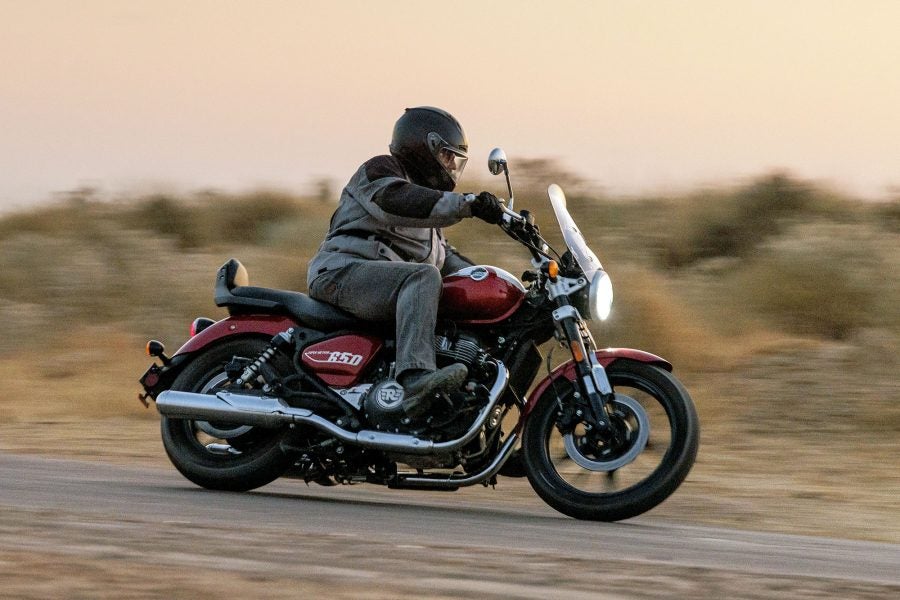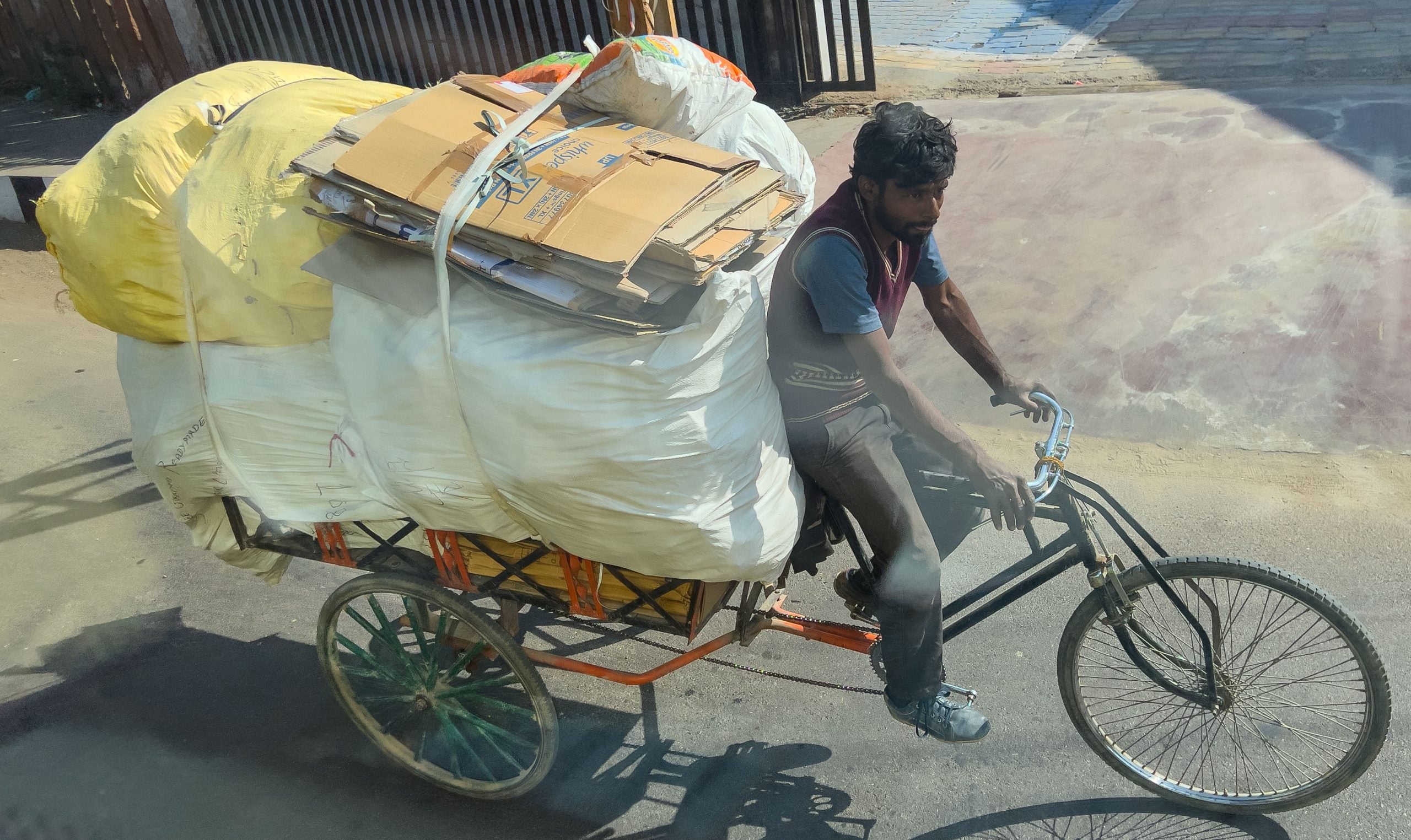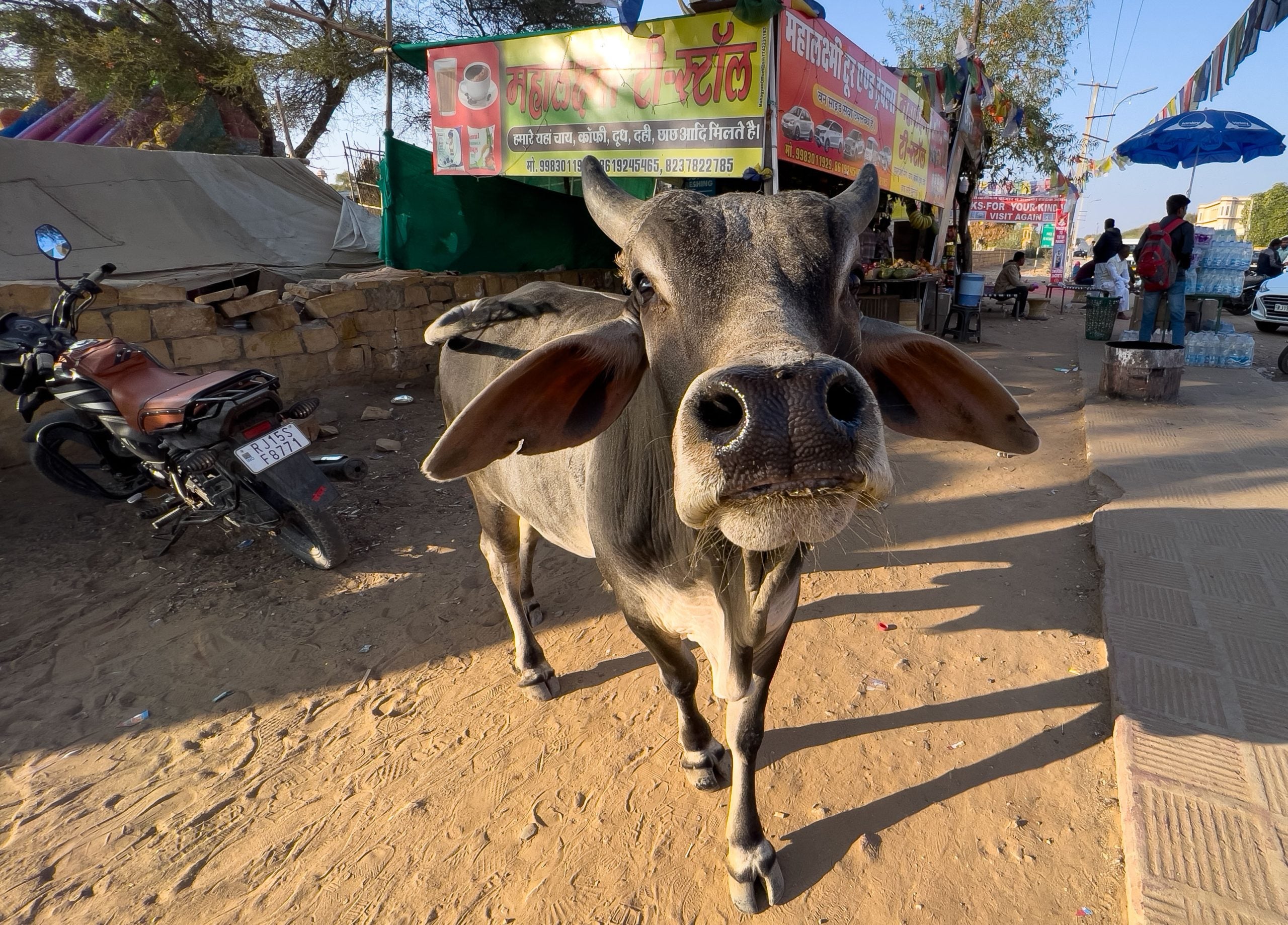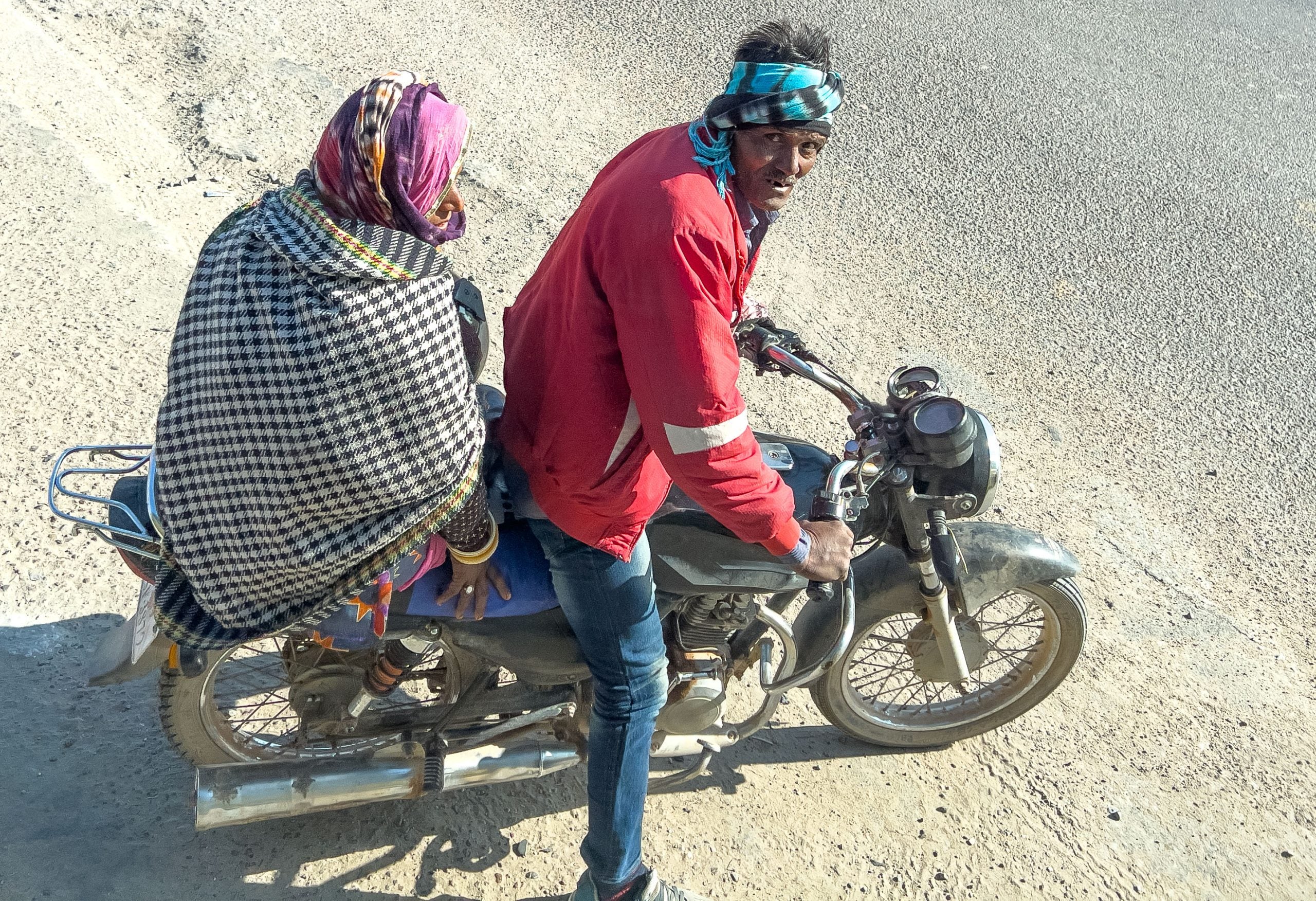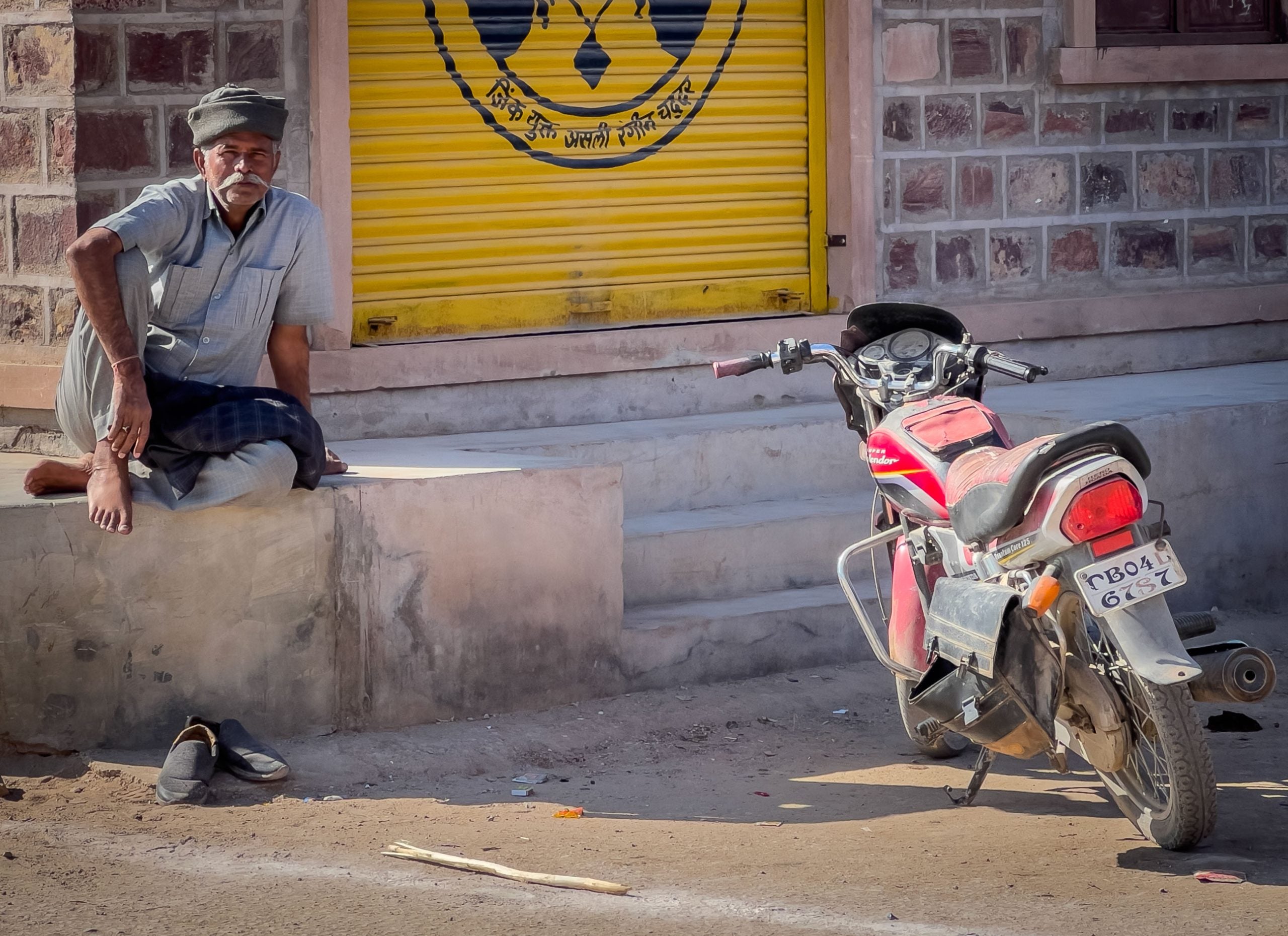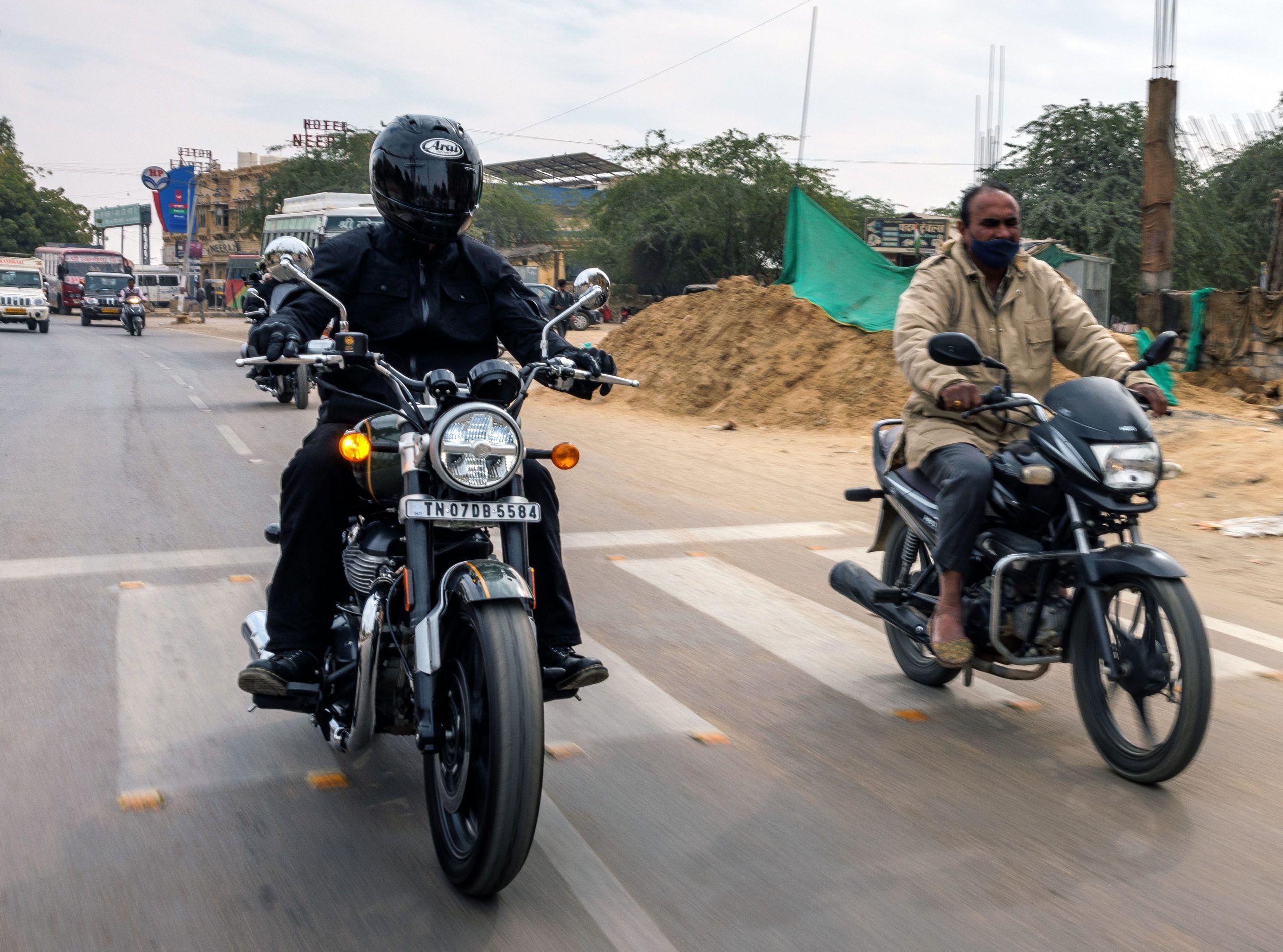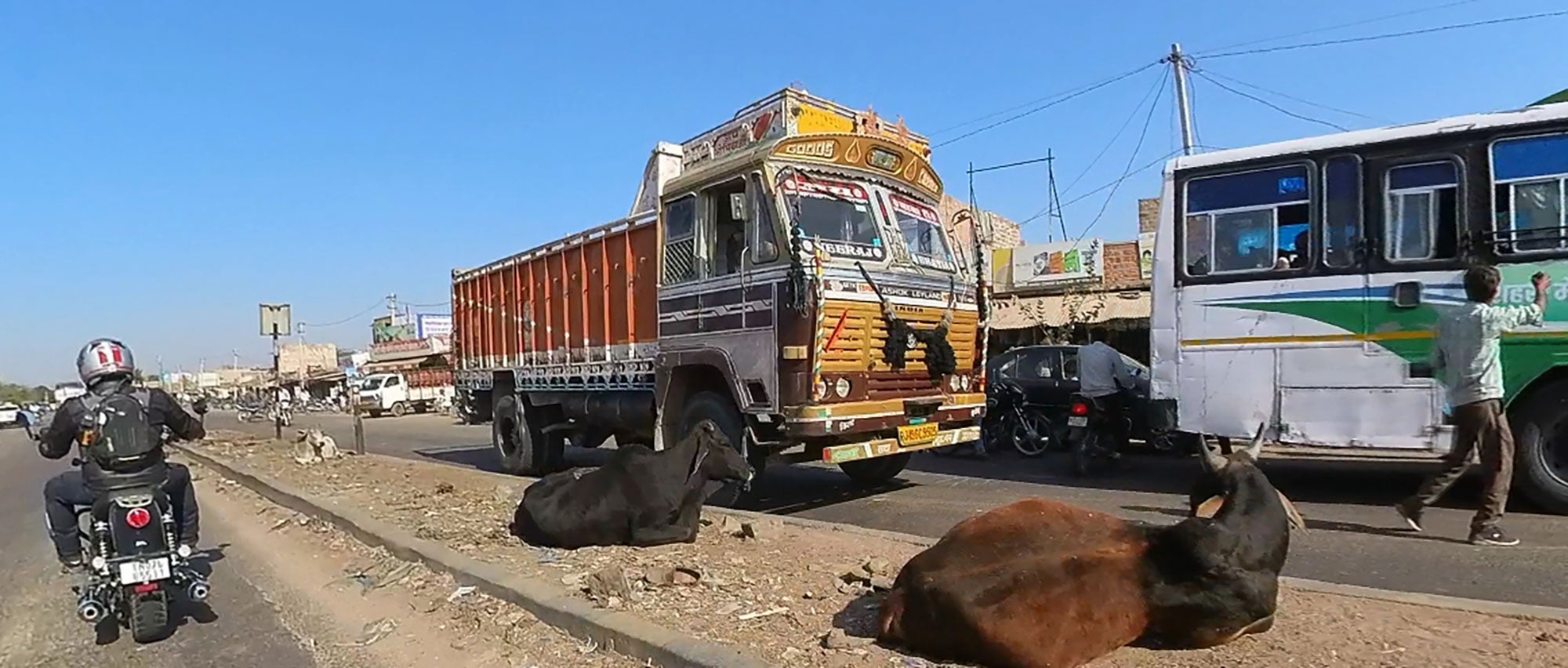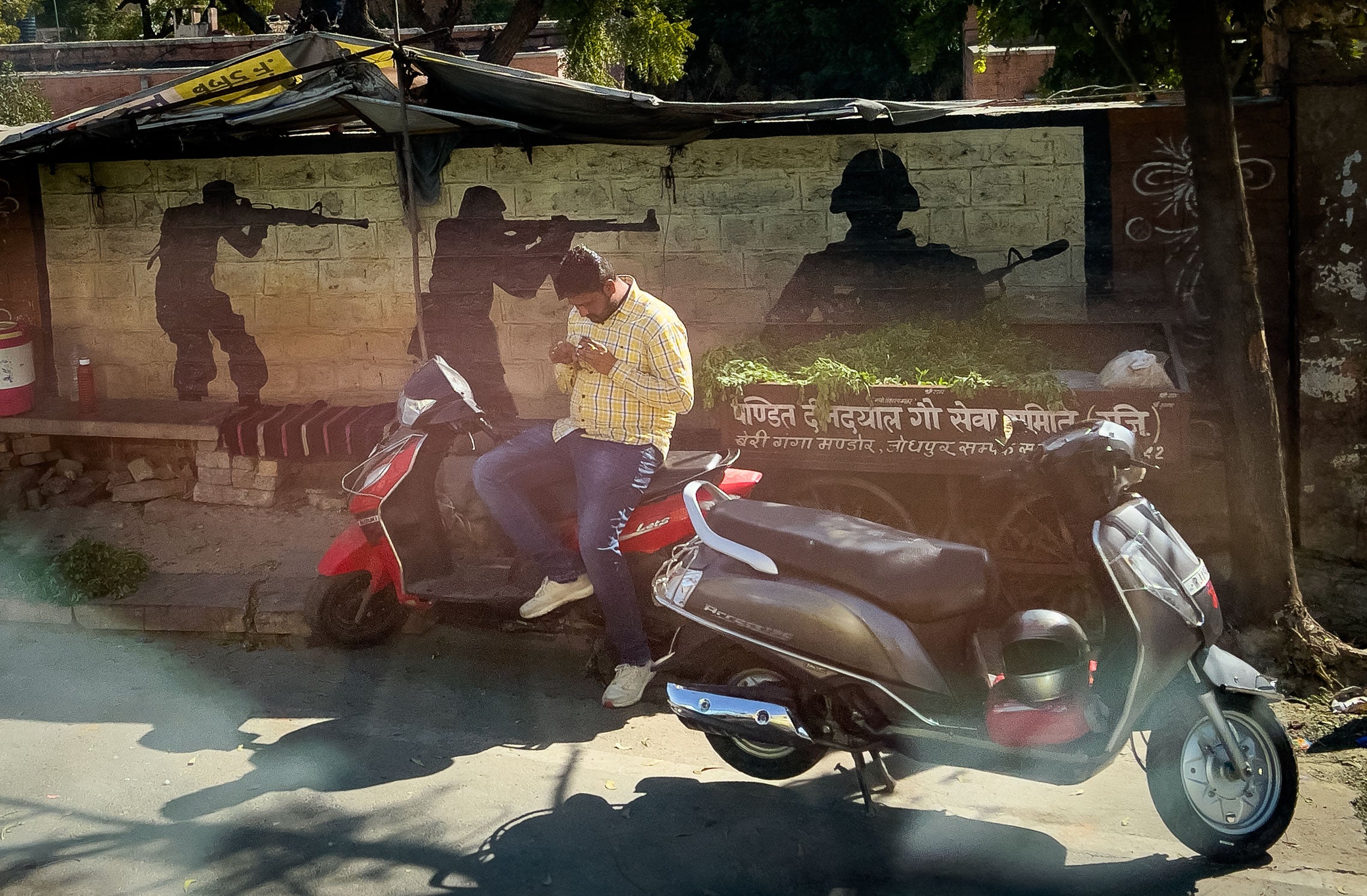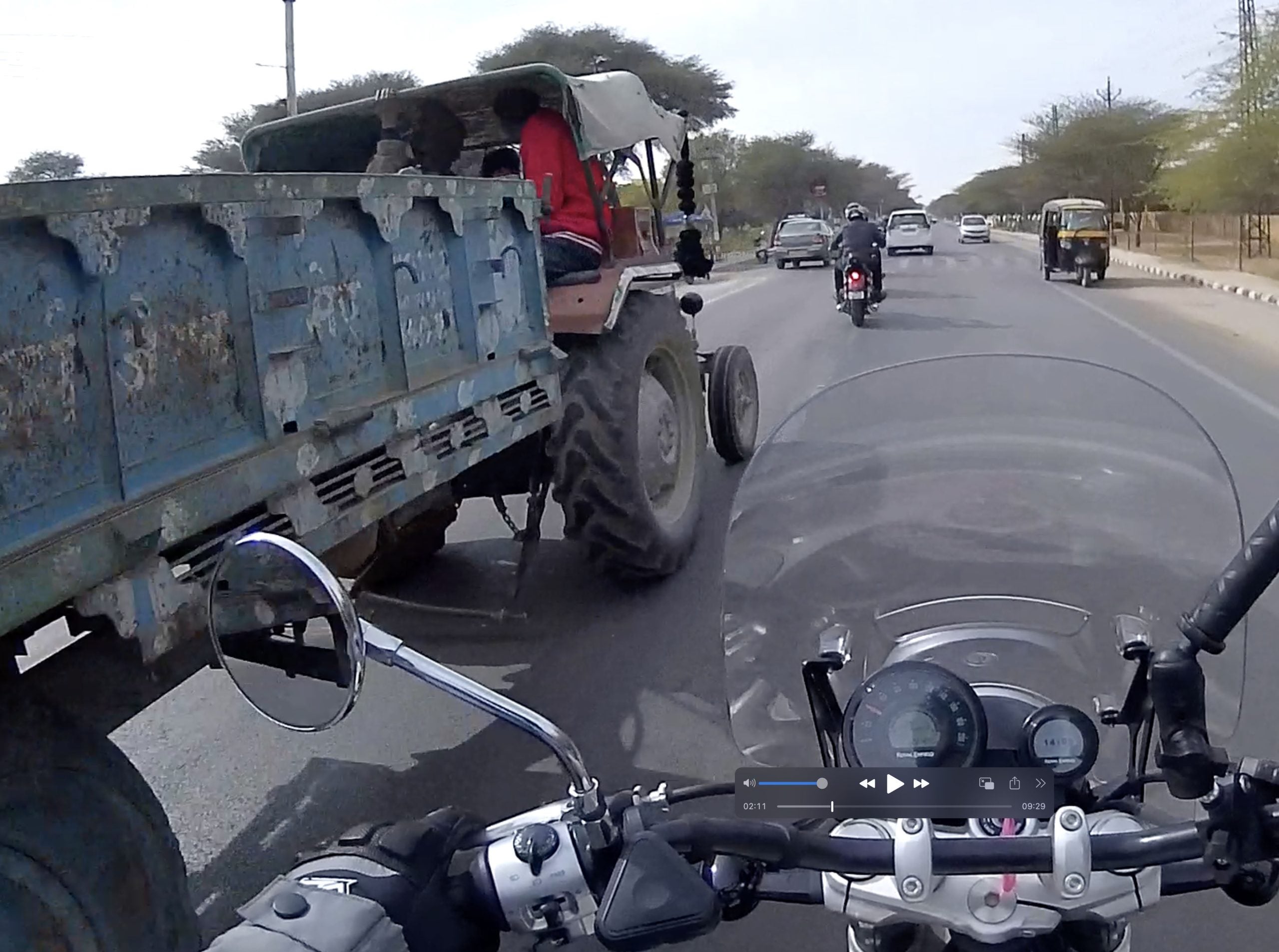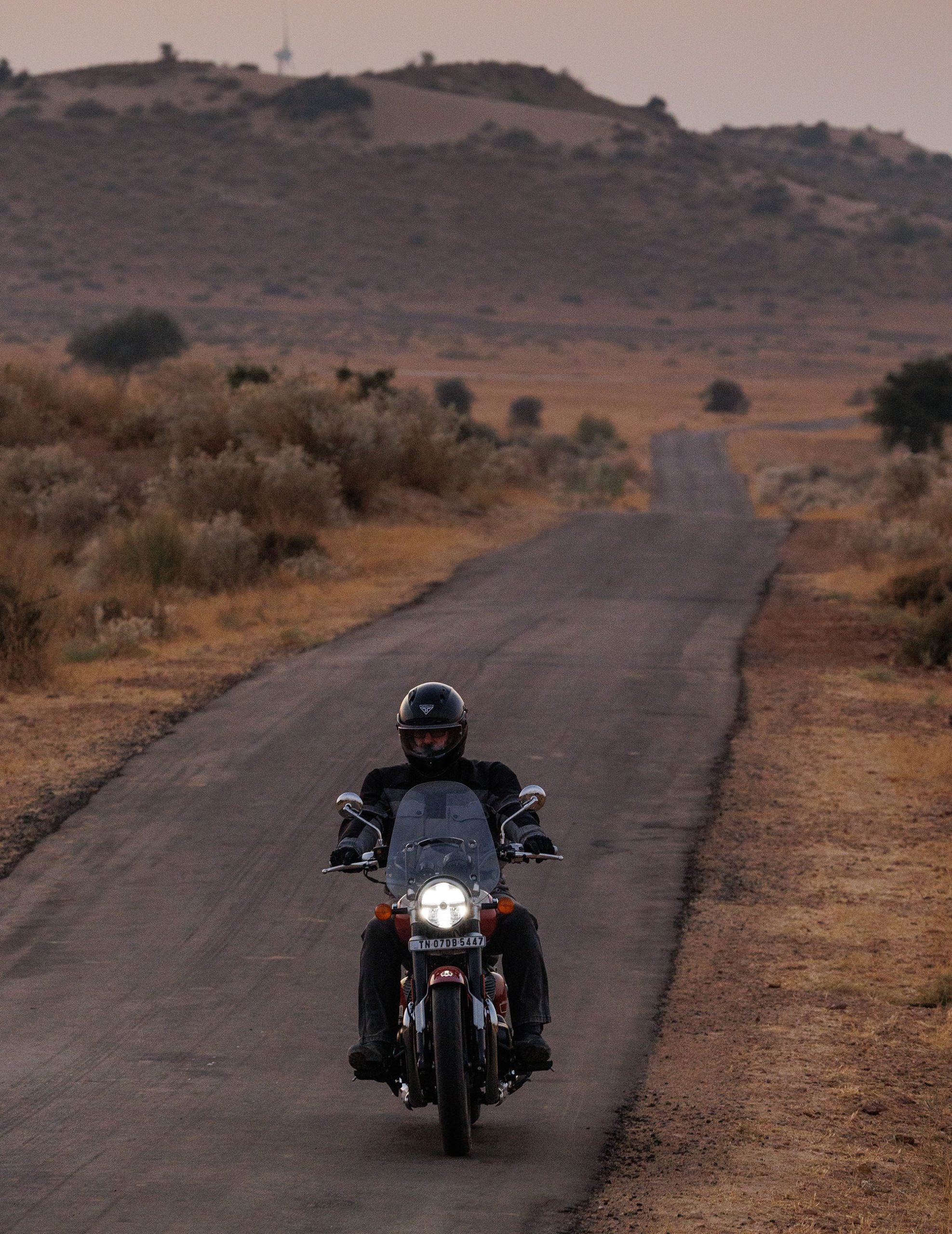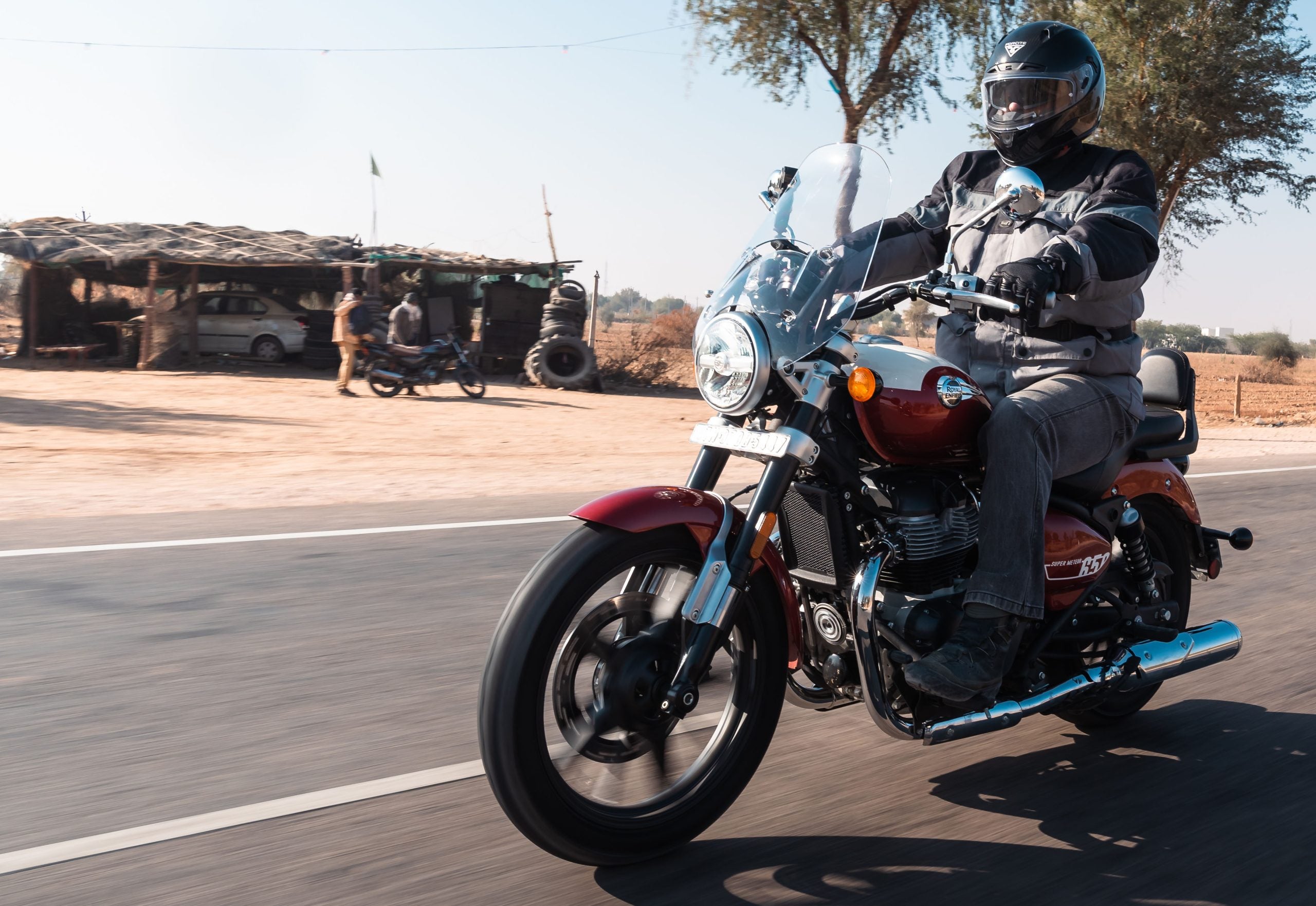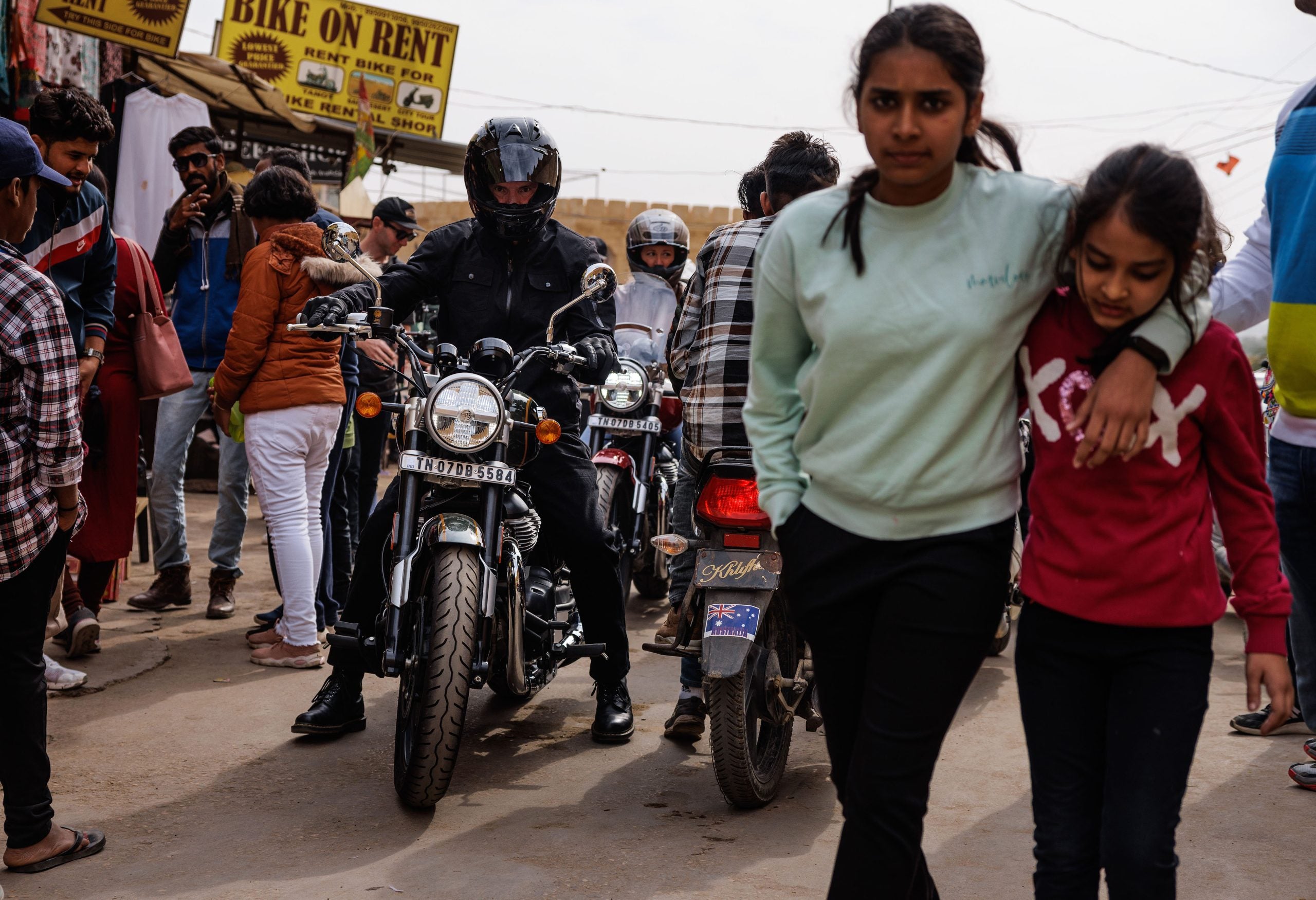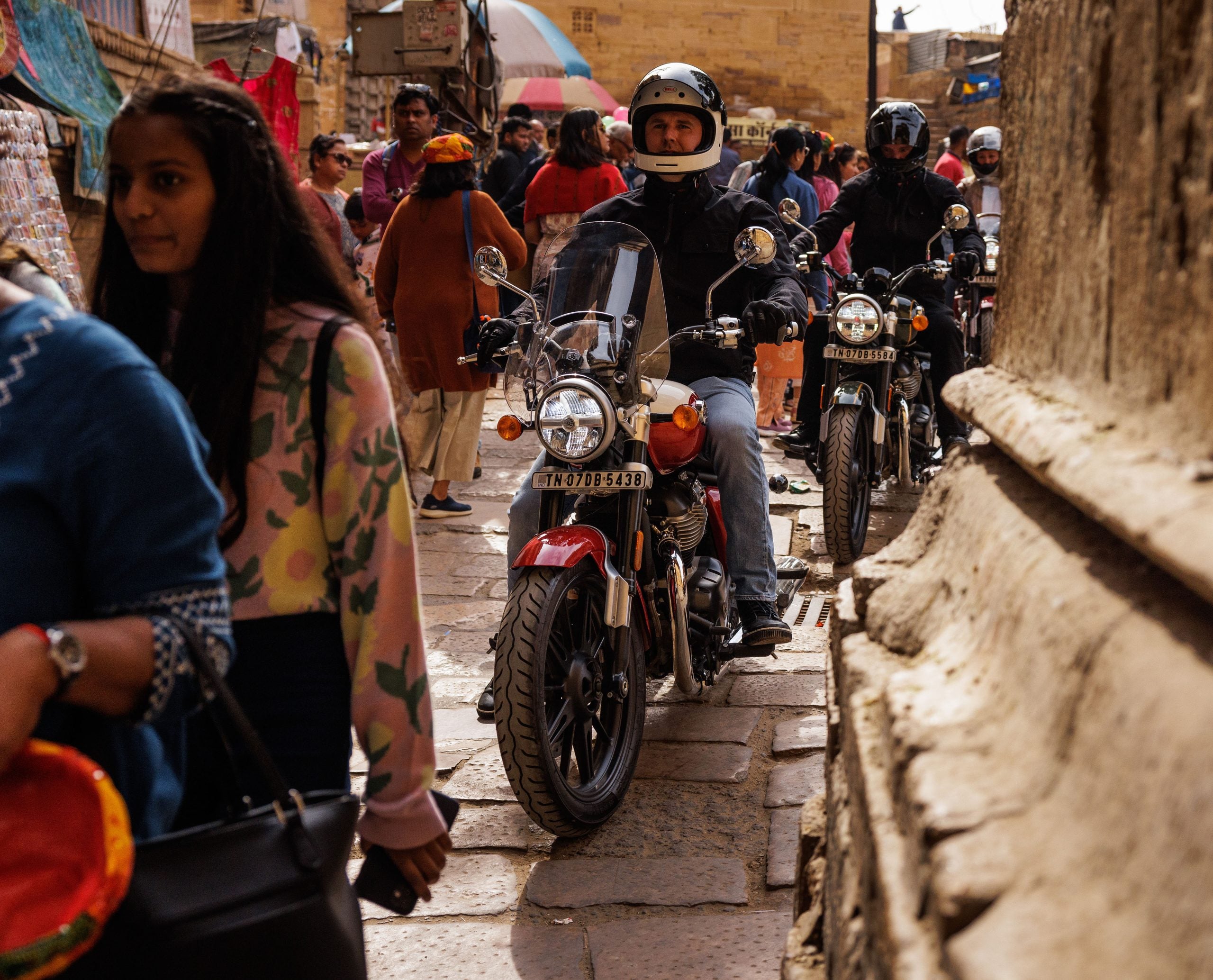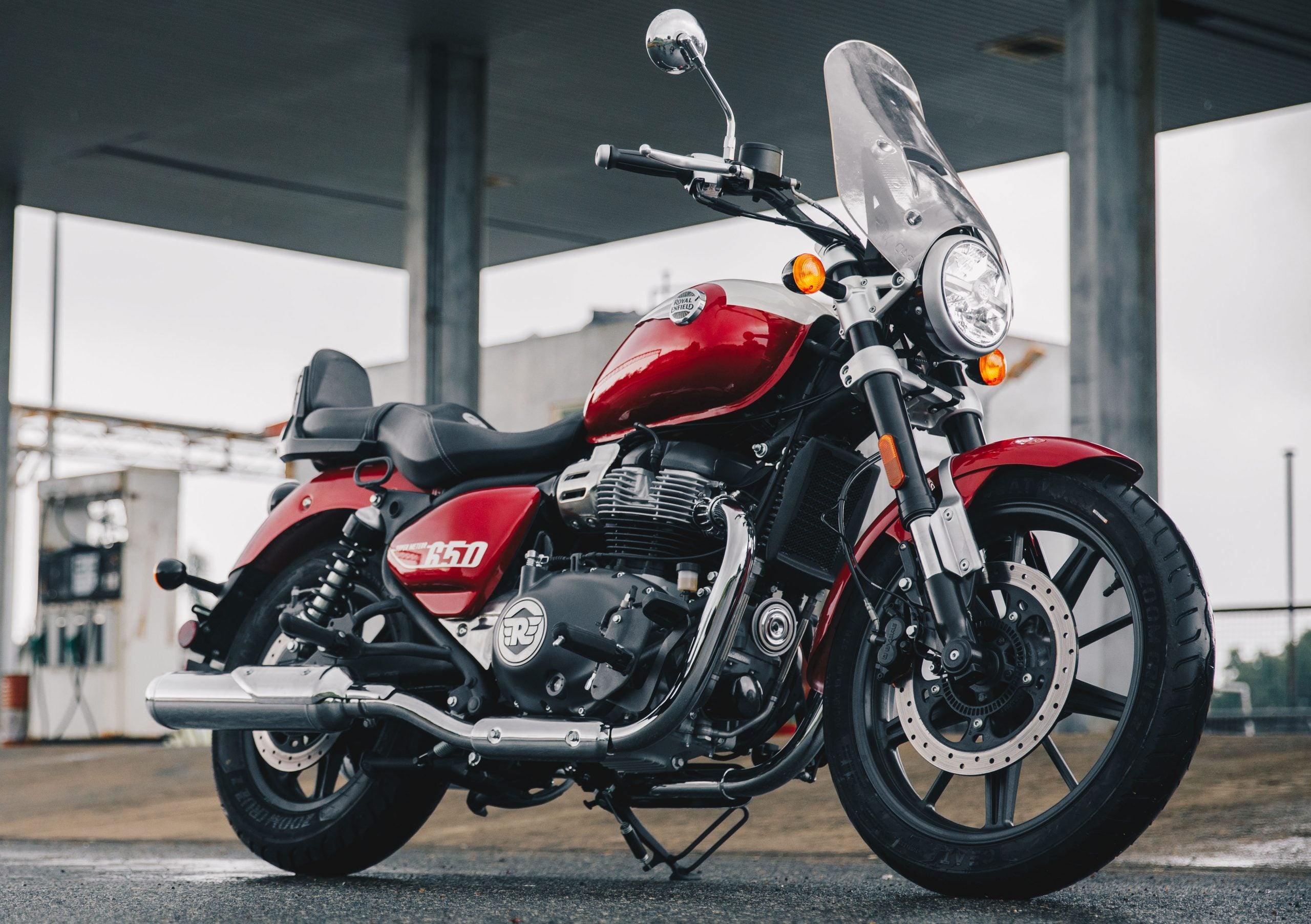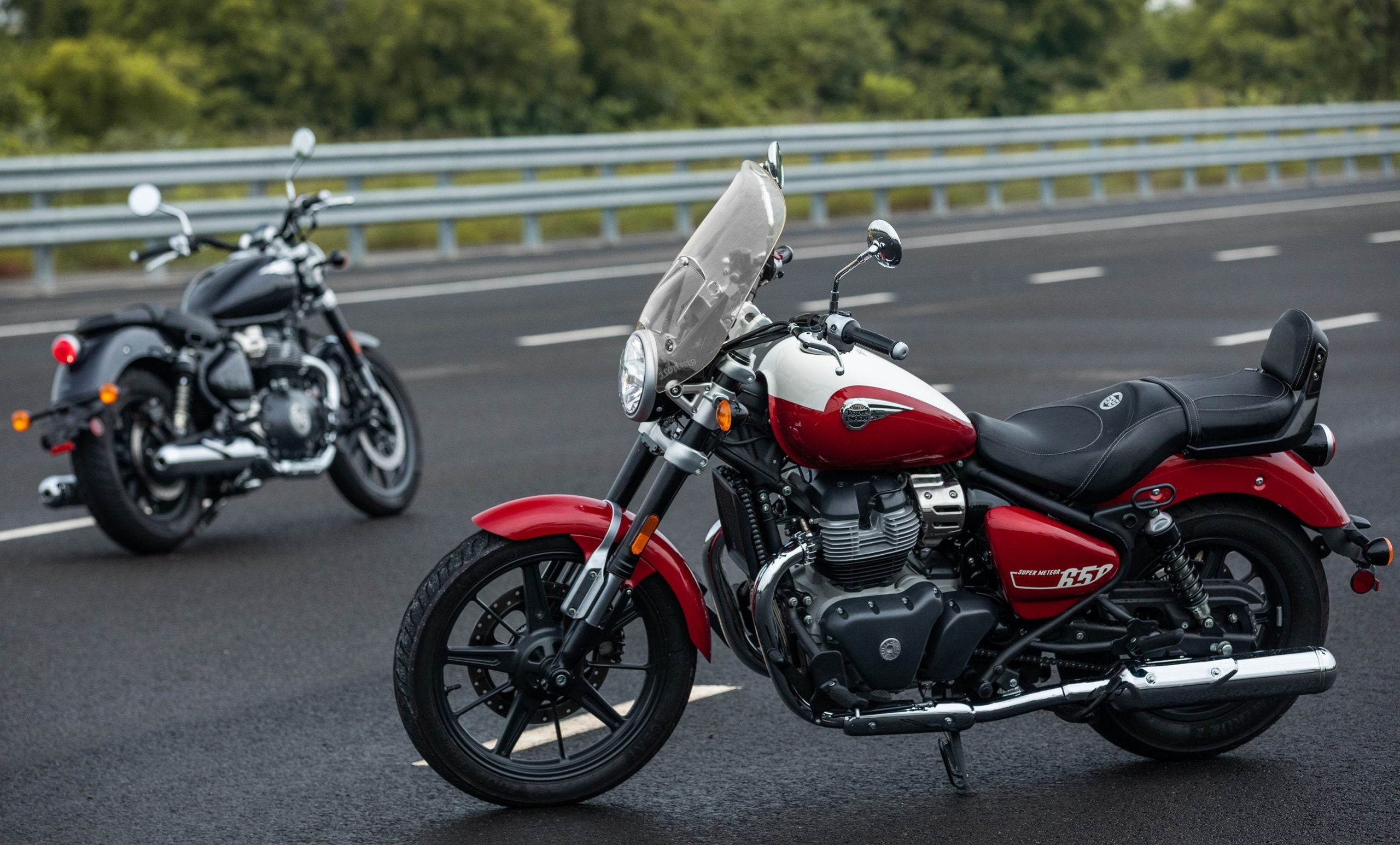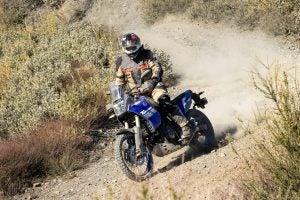Heads up! Look around, and you’ll see all sorts of stories about the Royal Enfield Super Meteor launching in North America this month. We actually had a ride review of the bike all the way back in February, when William Roberson traveled to India to ride the machine on its home turf, Here’s that review for you once again, to remind you what the bike is all about—Ed.
Back in 2020, I reviewed Royal Enfield’s then still fairly-new-to-market P-twin, the INT650, for another publication and when offered the review bike at a friendly price, I bit and hoped I hadn’t made an expensive mistake. The INT650—or Interceptor 650 everywhere except the US—had been a gem to ride during the review period, but it was essentially an all-new design coming from the recently revitalized company, long based in India after folding in the UK in the 1960s. It was unclear if the new 650 twin would hold together and be reliable in the years ahead, so yes, I was taking a chance—but I also had a good feeling about it.

The Royal Enfield INT650, the first of the 650 P-twins, aka 650 Interceptor outside the US. Photo: William Roberson
Paying homage to Enfield’s original P-twin Interceptor from decades gone by but with a clean-sheet design loaded with modern tech and manufacturing methods, I still worried dots of oil might appear under the INT650 in the garage or that lights would suddenly flicker and die far from home, as was the legacy of the stasis 350 and 500cc Bullet singles Royal Enfield made for decades on end while the rest of the motorcycle world moved forward.
So far, neither has happened, and the INT650 has continued to be reliable, oil tight, and above all, a joy to ride. Now, after riding the Interceptor’s newest sibling, the Super Meteor 650, in India for several days, I feel very, very reassured that my INT650 will be a fun and enjoyable companion for years to come.
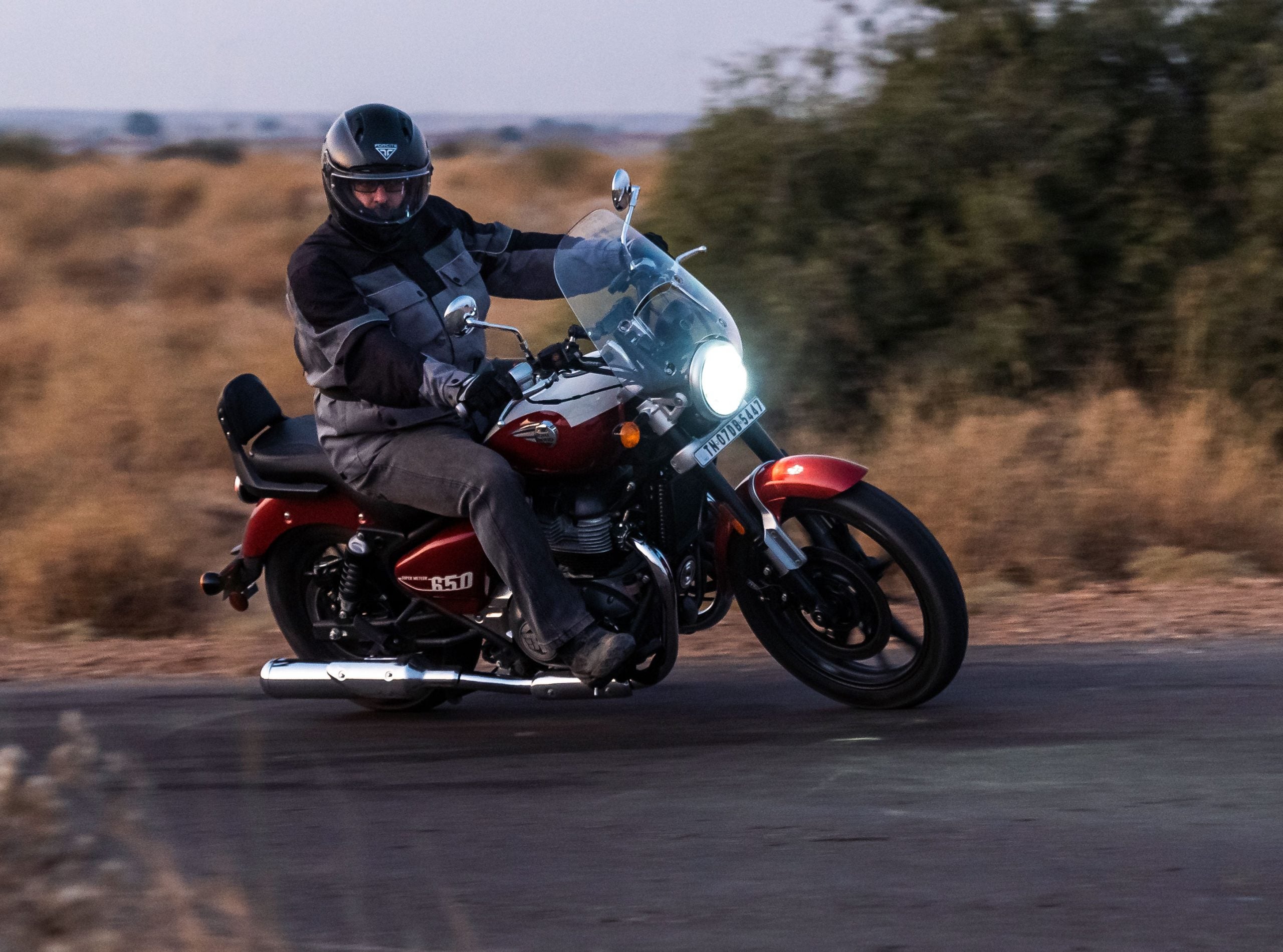
Good bike, rural road, golden hour. My day is complete. Photo: Royal Enfield/360Media
If you’ve never ridden a motorcycle in India, I’m here to tell you it is an intense and unforgiving proving ground. I did all the things on my two Super Meteor 650 press ride bikes that I would hesitate (or never intentionally) do with my personal INT650 twin, like bounce it off the rev limiter repeatedly, catch air off surprise speed bumps, push the brakes to ABS activation, blast it through deep sand and more, all the while dicing with cars, trucks, cows, dogs, goats, pedestrians, other motorcycles, scooters, bicycles and the occasional peacock—often all at once—in crowded urban centers and small towns. Throughout, my basically new (under 100 km showing) Super Meteor 650 machines never hiccuped, hesitated or gave any indication they were overly stressed. Because, basically, they were built for that kind of abuse—or what is clearly regarded as “everyday riding” in India.
The Bike
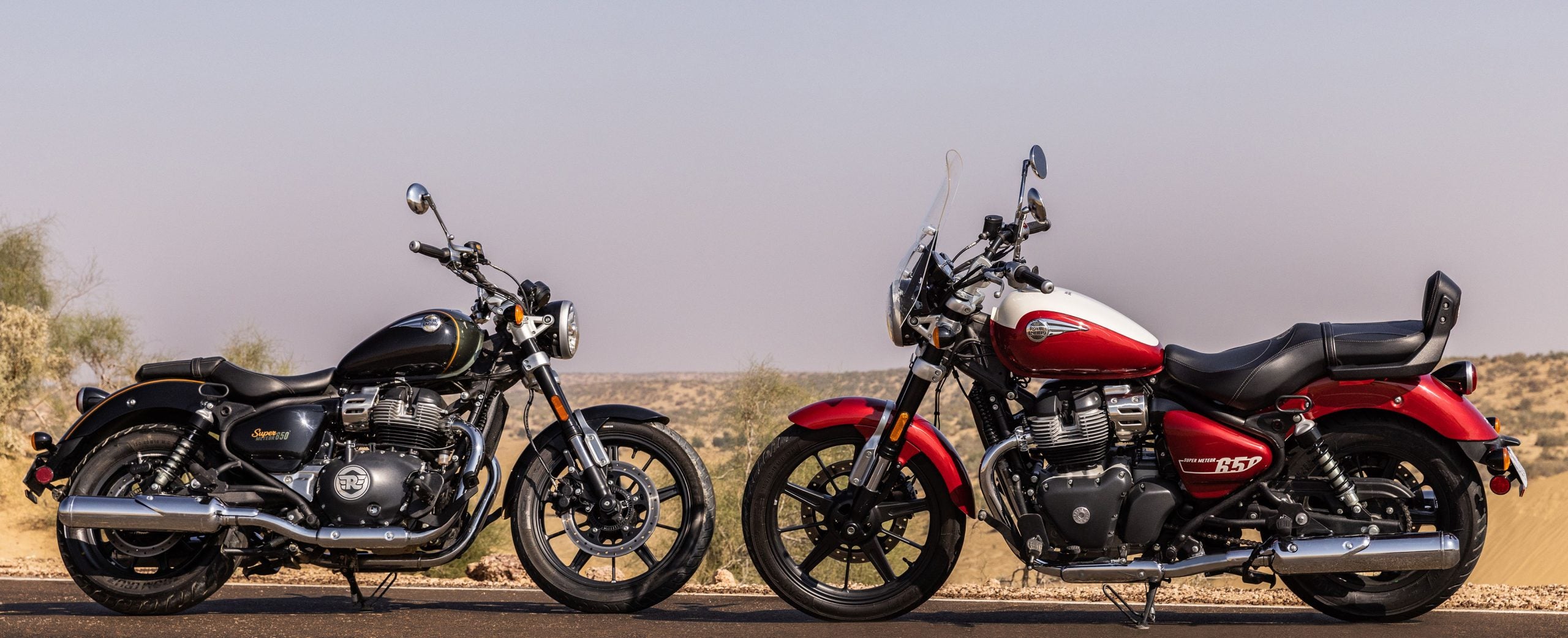
The base bike, left, and the base Touring configuration with windscreen, backrest and Touring saddle. Photo: Royal Enfield/360Media
Like the Interceptor 650 twin, the Super Meteor 650 is another essentially clean-sheet machine from Royal Enfield, but this time in a more “cruiser” or touring format. But at its heart is that now-proven air/oil-cooled 47-horsepower 648cc P-twin with four valves per cylinder, a 270-degree firing cadence, 38.5 pound-feet of torque, fuel injection, six speeds, chain drive and a sizeable oil cooler.
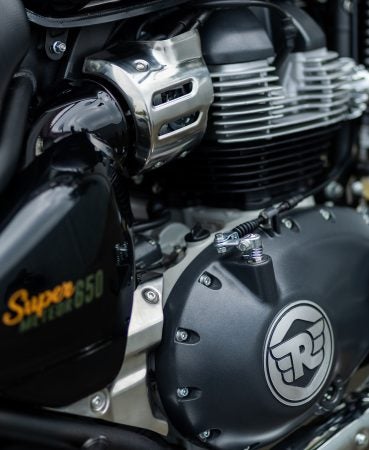
The now proven 648cc P-twin has gotten some updates, and the cases have a new look as well. Photo: Royal Enfield/360Media
The exterior cases have been re-worked and re-finished a bit and the internals have been tweaked as well including some head work, but overall, it’s the same happy heart that’s in my Interceptor. Enfield calls it the “Version 2.0” of the 650. The 531-pound (wet) Super Meteor 650 is now Royal Enfield’s top-line bike. Brits will need to pony up 6,799 Pounds and 7,890 Euros in France. US pricing has yet to be announced. My best guess is to expect it to come in around $7,000, and we will update the US price when it is announced to see how close I get.
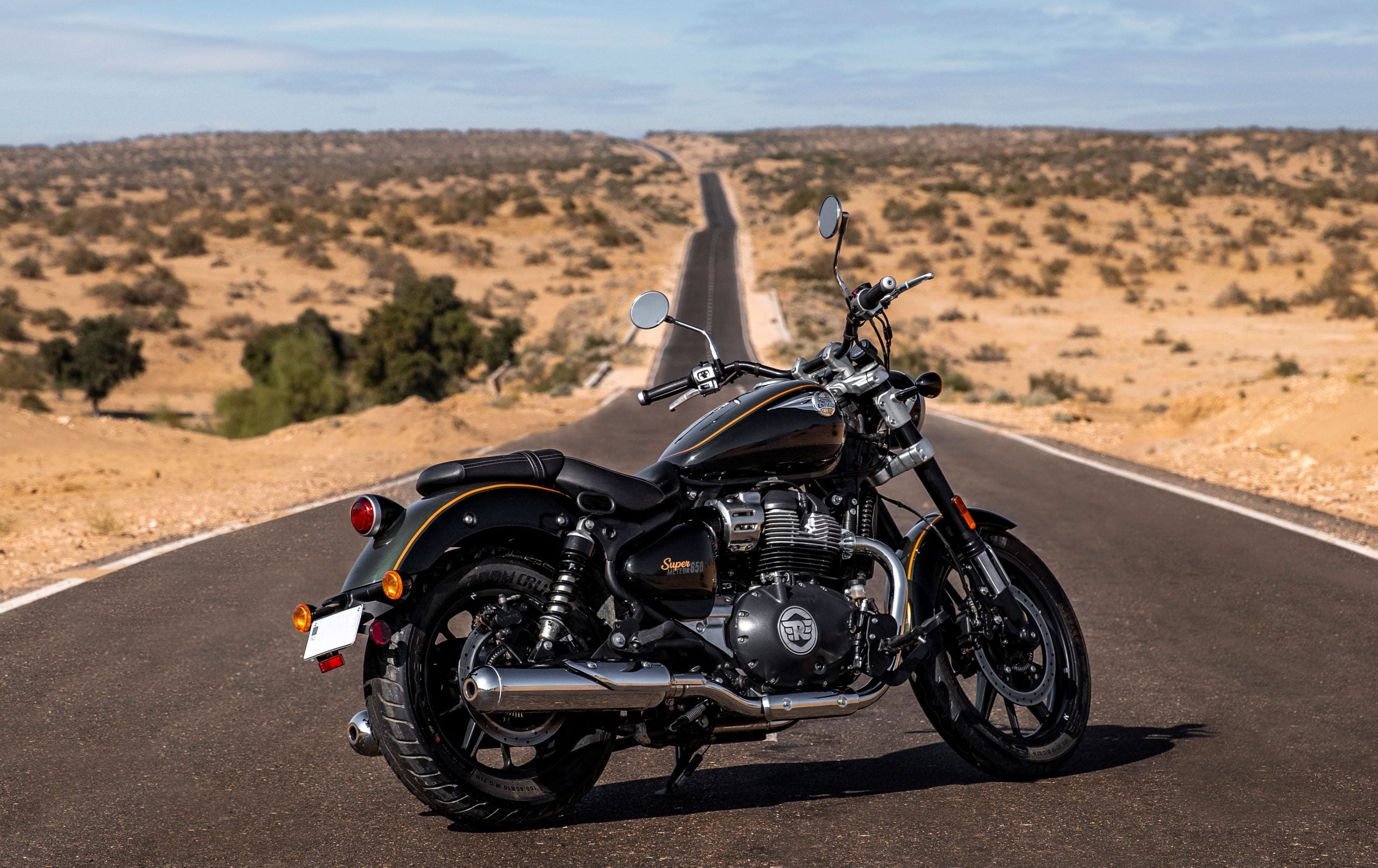
The base bike is closer to a standard than a bagger. A good thing. Photo: Royal Enfield/360Media
And yes, it is a “cruiser,” per Indian parlance, with forward controls, a bit of rake and pull-back bars. But it also has a fair bit of suspension travel and ride height, coupled with a low seat. You can choose from a wide range of RE bits for touring duty, including hard panniers, windscreens, seats and in some markets, different wheels and trim bits. It can also be nicely stripped down to a single-seater. I rode both a turn-key basic “Tour” version with windscreen, touring seat and backrest as well as the bare-bones base bike for comparison. Outside of the accessories, however, both bikes are mechanically identical, and that holds true across Enfield’s international markets for the Super Meteor, simplifying production and parts needs.
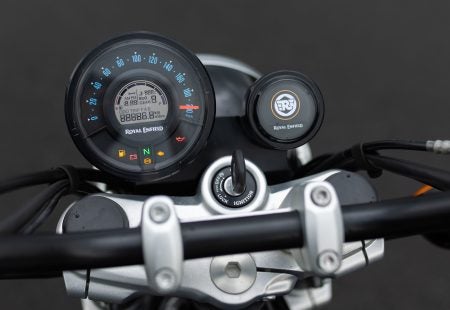
Tripper pod on right helps with navigation; it would be nice if it could work as a tach as well. Photo: Royal Enfield/360Media
Super Meteor construction includes a model-specific steel-tube frame, said tweaked power plant, but also a new non-adjustable Showa USD front fork with 110 mm of travel. The six-speed gearbox returns but without the slipper clutch, as does dual-channel ABS, twin rear shocks with 101 mm of travel and preload adjust, and a twin-pod instrument cluster that loses a tach but gains Enfield’s Google-based Tripper navigation tech that shows simplified directions while riding.
The headlight is now full-LED and a “Bullet” style single round LED tail light with halo brings up the rear. While fuel injection is standard on all 650 twins, there is no cruise control option since the EFI does not work via throttle-by-wire. The throttle has actual push-pull cables that turn the throttle body valves in a sort of blend of old and new tech. My 1994 BMW RS oilhead uses essentially the same system, but Enfield’s is more refined.
Ahead of Enfield’s new P-twin production, parent company Eicher Motors absorbed iconic frame designer Harris Performance, and that has paid dividends. Both my INT650 and the Super Meteor ride with neutrality and great front-rear balance, and change direction without complaint. And while the Super Meteor is set up as a foot-forward cruiser, the geometry is much more akin to a standard than a typical long-and-low American-made cruiser, so much so I wondered if a mid-mount control set was an option (so far, no, at least not OEM).
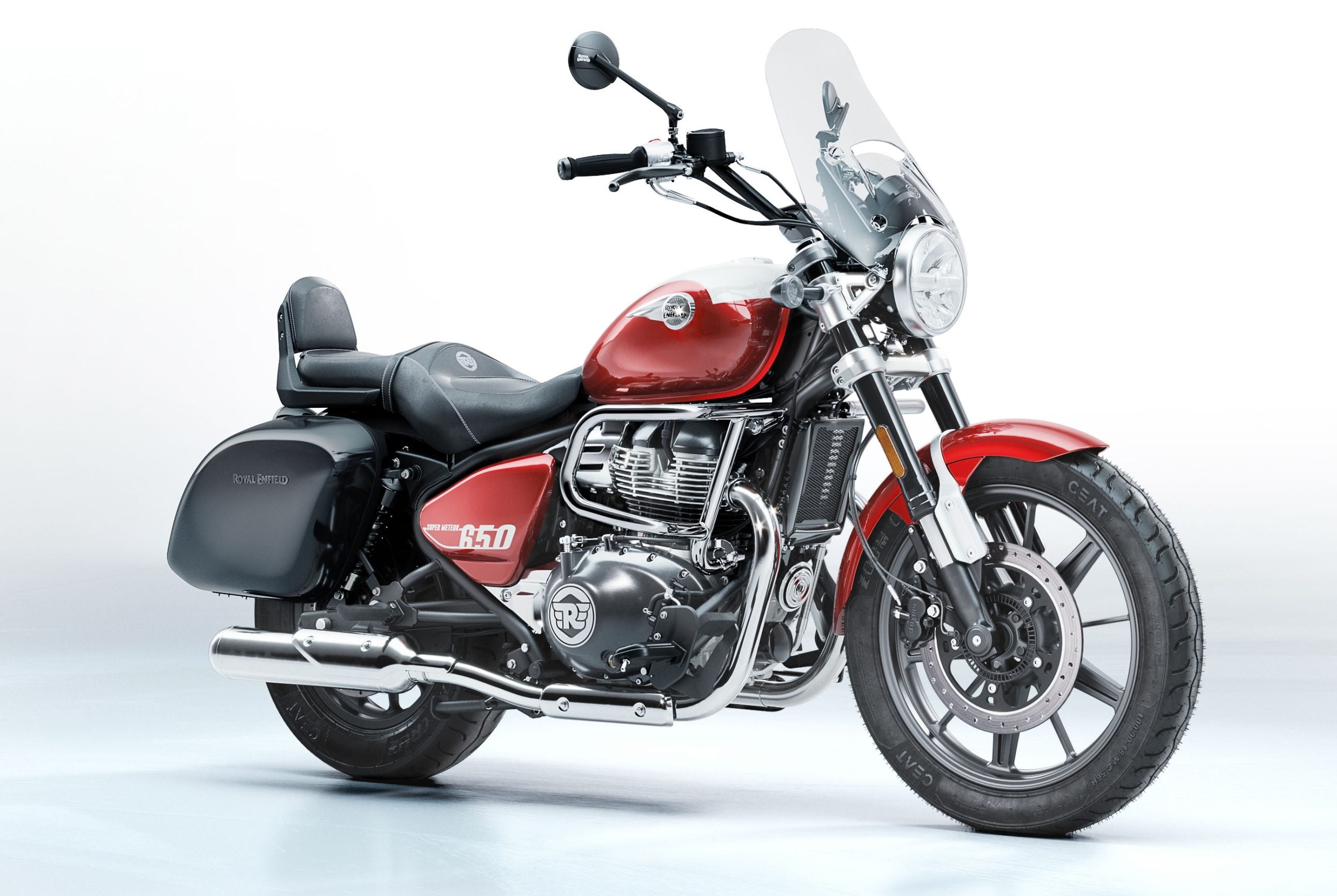
An accessorized Super Meteor 650 with hard bags, engine bars and more. Photo: Royal Enfield/360Media
And this is no raked-out short-hop chopper by a long shot. I rode all day for two days in comfort, as the “forward controls” are not very far forward and you sit upright controlling mid-bend bars, not mini-apes. As noted, I rode two Super Meteors, one standard bike and the other optioned for touring with a different (better) saddle, small backrest and small vented windscreen. The Tourer’s seat is indeed more comfy than the basic bike, but only just. Both were a good fit for my 34-inch inseam, but everyone seemed to fit well on the bikes, including a 5-foot and not much more female journalist who could flat-foot at stops.
At a presentation for the Super Meteor, Royal Enfield designers stressed how they wanted the bike to be a capable and affordable mid-size “cruiser,” which in India also translates to “tourer.” In country, Royal Enfield motorcycles are a premium choice as the riding public is mostly aboard small, inexpensive Asian-made 110 to 125 cc air-cooled, drum-braked machines that top out at maybe 50 mph depending on how they’re loaded. The Interceptor, Continental GT and Super Meteor equate to aspirational bikes for most Indian consumers, much like a higher-end Ducati or BMW is for riders elsewhere. That said, older Royal Enfield models, typically 350 (below) and 500 cc single-cylinder Bullet models, were common along our ride route.

A handsome local resident astride a late-model Enfield Bullet 350 kitted with crash bars, horns, racks and sari guard. Photo: William Roberson
In India, the Royal Enfield Bullet is akin to mechanical religion, much like the Jeep or Harleys in the U.S. Whole industries have been built around maintaining and accessorizing the older bikes, and current management says new Enfields will have strong parts and accessories support going forward.
Riding In India: Brace Yourself
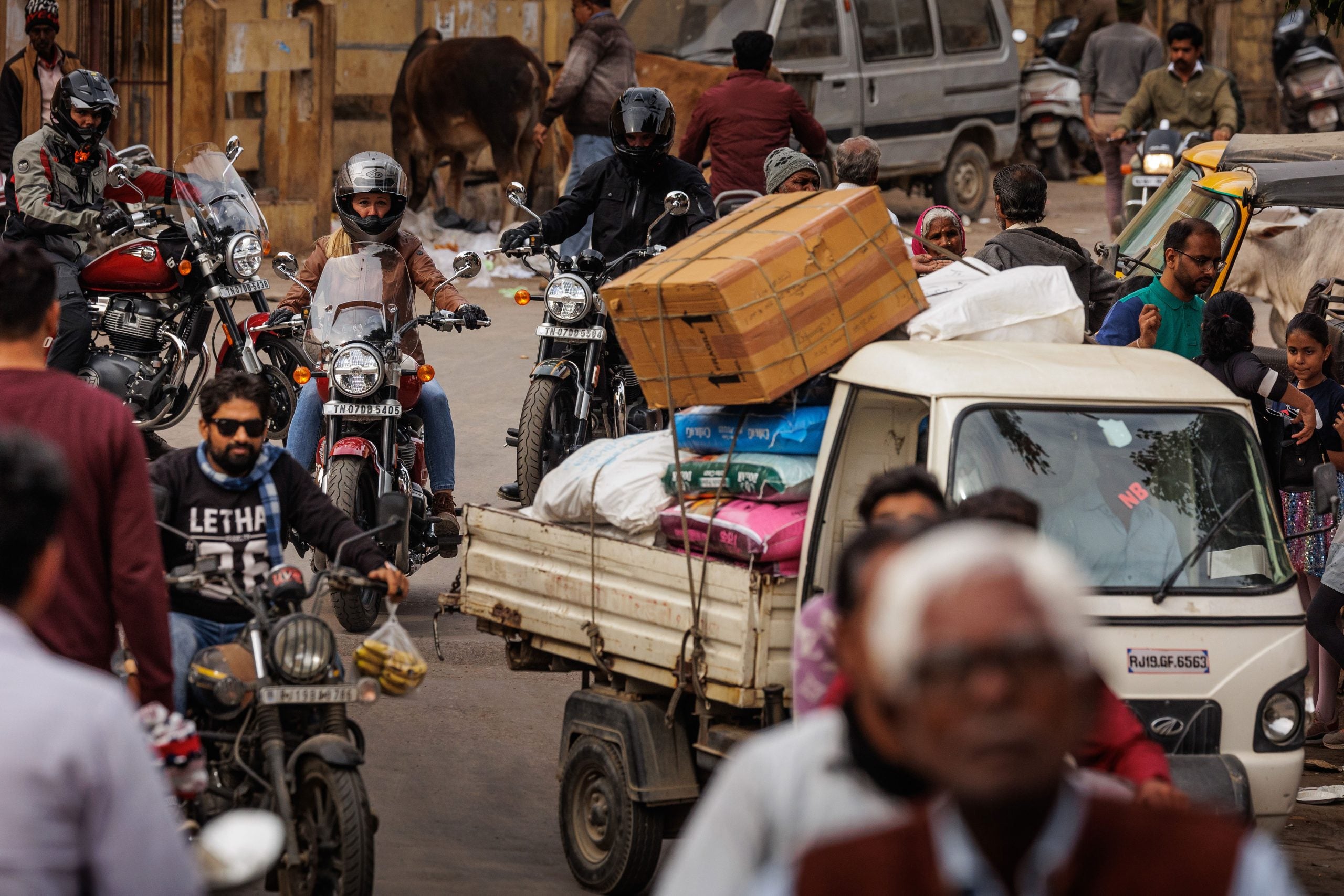
Traffic in India can be… complicated, but it never stops moving. Photo: Royal Enfield/360Media
After landing late at night in a fog-shrouded Delhi (formerly New Delhi), we hopped a short domestic SpiceJet flight to Jaisalmer, located western mid-continent. On a cool morning with temps in the low 40s Fahrenheit, dozens of journalists from around the world, along with Managing Director of Eicher Motors, Siddhartha Lal (below, right), Royal Enfield CEO, B. Govindarajan and CFO Vidhya Srinivasan all saddled up newly minted Super Meteors and set out for a scenic loop around the region surrounding Jaisalmer. Located near the border with nuclear-armed neighbor Pakistan, our lodgings were near a busy airbase, and fighter jets in full afterburner would often roar overhead at low altitude as they headed out on patrol. We were definitely not in Kansas anymore.
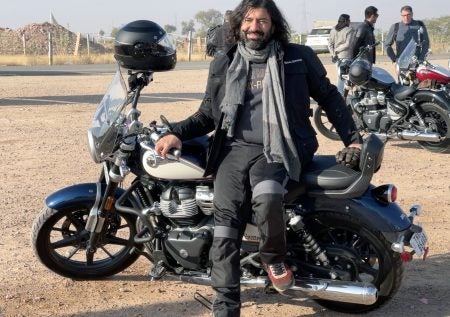
Siddhartha Lal, 49, Managing Director of Eicher Motors and the man planning the future of Royal Enfield. And yes, he’s as cool as he looks. Photo: William Roberson
Perhaps scenic is the wrong word for our first sortie on the Super Meteor 650: by turns terrifying and exhilarating would be much more accurate. Yes, the area was lovely to ride though (and it was mostly flat), but navigating down India’s highways and through small towns is a true adventure, no matter what kind of bike you’re on.
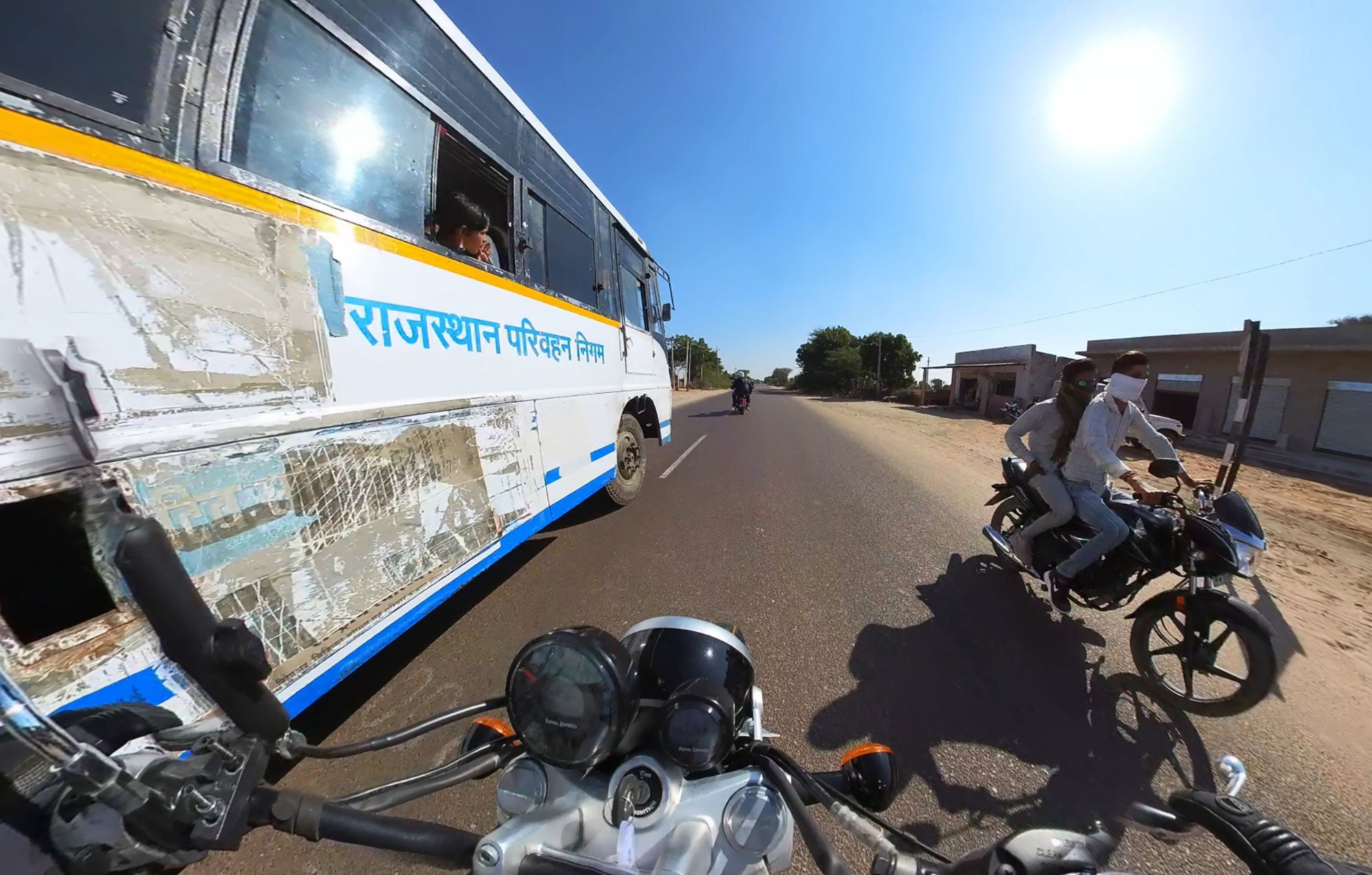
Everyone passes everyone in India. I’m passing this big bus, so the oncoming rider (right) eased onto the shoulder to make room. That’s one way the traffic keeps moving. Photo: William Roberson
For an American used to other road users largely obeying traffic laws and riding on generally smooth, wide roads with “just” cars, trucks and other motorcycles, India may as well be another planet. You ride on the left (as in the UK, Japan, etc.), but the hazards are many and varied. In the space of 50 yards, roads can go from US-spec clean and clear two-lane freeways to rutted, potholed, speed-bumped obstacle courses through small towns. However, the Super Meteor (and pretty much all Enfields) are built with this in mind, and made their way through the rough stuff, including deep sand, dirt, rubble, water-logged streets, cobblestones and potholed, crumbling pavement without complaint and with a high degree of control and comfort.

Ten seconds ago, this was a paved country road. Now it’s cobblestones – most of the time. Be ready for anything while riding in India. Photo: William Roberson
Traffic signals (stoplights, etc.) and speed limit signs are almost non-existent, even in the larger towns we passed through, as is any semblance of “law enforcement” for speeding or otherwise. However, the fastest most people go on the highways is about 50 mph since that’s the top speed of the ubiquitous small motorbikes and many larger vehicles. Since road conditions can change in an instant, it’s not really advisable to go much faster.
As such, passing is the name of the game, and it’s not uncommon for a packed-out bus going 40 to pass a farm tractor pulling a load of hay (and people) going 20 while the bus is simultaneously being passed by a private car, motorcycle or a faster bus or truck going 50 mph or so—and all on a two-lane highway. At the same time. In the US, road shoulders are for emergencies. In India, it’s just two more lanes.

Just keep calm, pass along and carry on. Photo: William Roberson
Astride my powerful 650cc rocket bike—the fastest thing on the local roads by far—and confronted with just such a spectacle and a combined closing speed of close to 100 mph (160 km/h), I simply followed the local riders over to the narrow, dirt-and-debris covered left shoulder as the triplet of vehicles blurred past literally inches away, then went back into my lane wide-eyed, often without scrubbing off even a modicum of speed. That will wake you right up.
Gaining confidence, I also sometimes split between one vehicle and an oncoming vehicle on the open highway (as below), a move that would be an instant ticket or death wish in many other places. But in India, it’s just another way to keep moving forward, and riders and drivers ease over to give you a bit more room to pass. It is a delightful ballet of manners and motion.
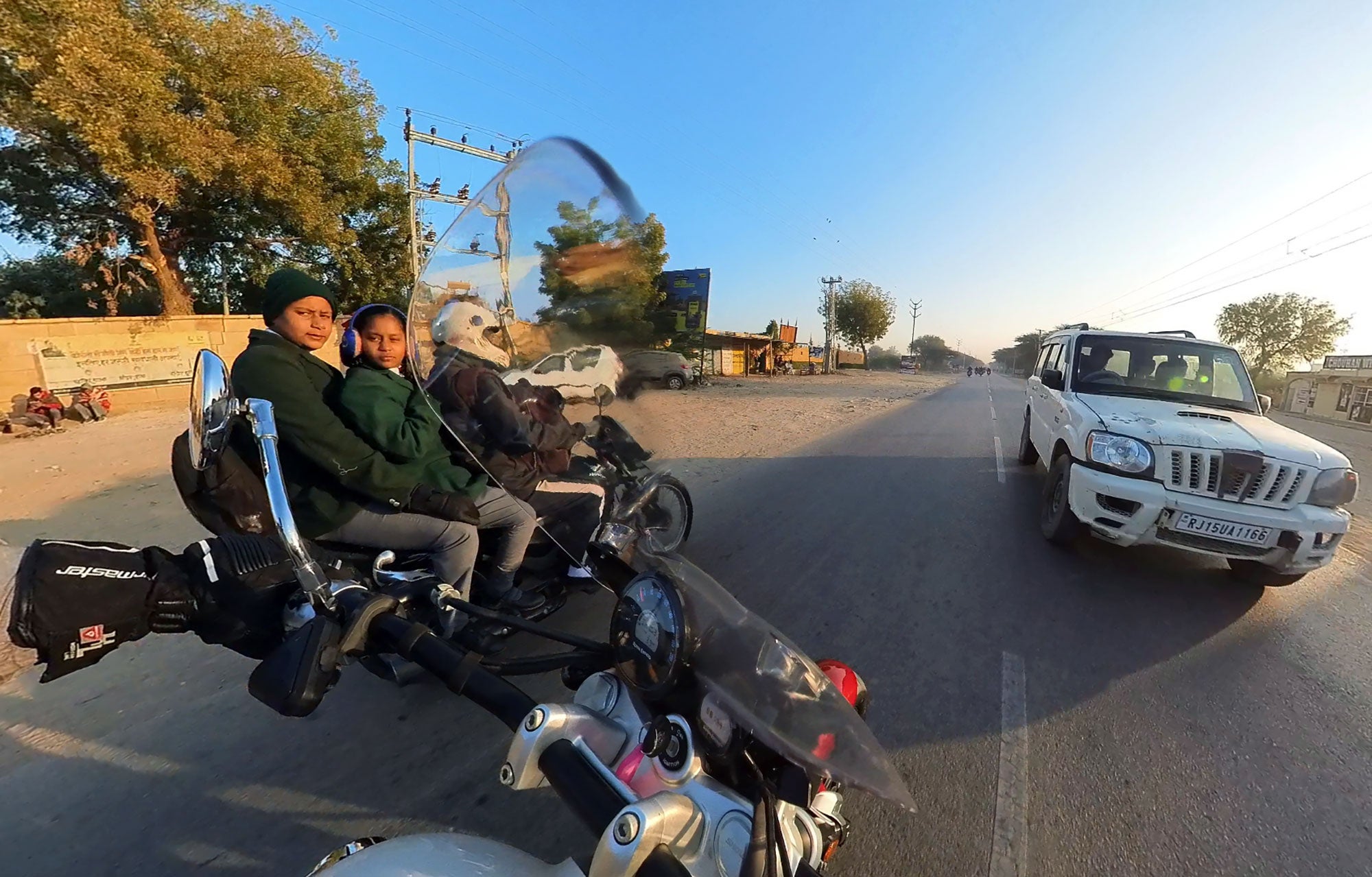
Tight quarters to be sure, but this is all part of riding in India. Photo: William Roberson
Indeed, how are India’s roadways not blood-soaked corridors of death out of a Mad Max movie? For one, locals all seem to have an almost sixth sense about how traffic moves, and communicate quite clearly while driving or riding by using their headlights and horns. A headlight blink from an oncoming vehicle essentially means “move over, I’m coming through,” and is often accompanied by an auditory element. For light trucks, cars, tuk tuks and motorbikes, a short beep beep is used like echolocation: heads up, here I am. A long beeeeeep or two is a more forceful plea to move over, speed up and/or merge. Large trucks have at least two sets of horns, a beeper/honker for said location notification, and a louder horn that honks and also plays a short musical number—very loudly—that signals “I’m a big truck” without being angry about it.
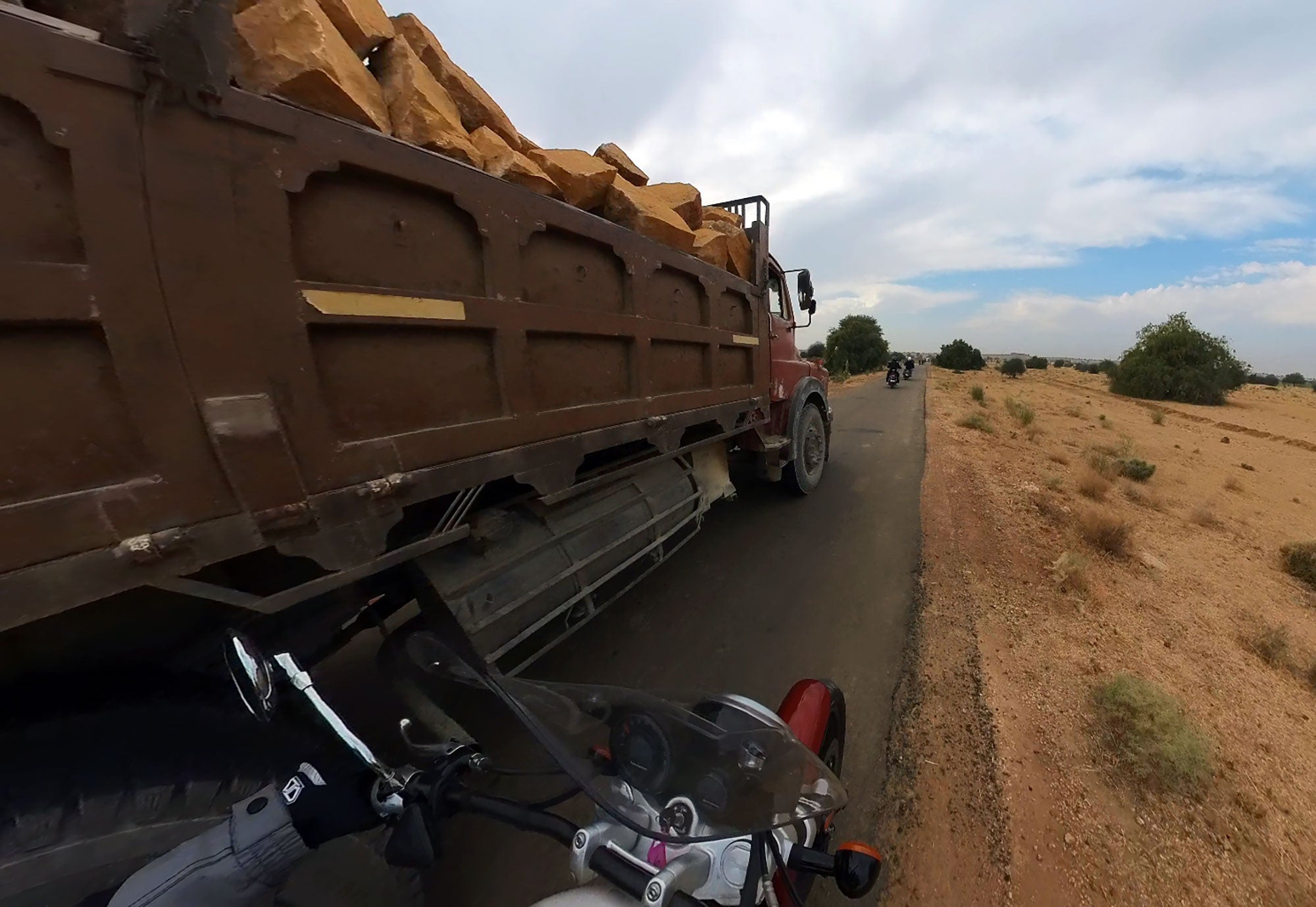
I gave this driver a few toots from my horn and he moved over about as far as he could on this narrow country road to let me pass. Note the “secured” load of concrete slabs. Photo: William Roberson
The use of turn signals is apparently either culturally inappropriate or just forgotten. Nobody except us tourists seemed to use them, and for the most part, brake lights (or any lights) seemed to be of relative low importance. The horn is king in India, and the result is a constant cacophony of honks, beeps, toots and melodies within cities and on the open roads.

Cows are everywhere in rural India, and they calmly share the road knowing they’ll be treated with respect. Photo: William Roberson
The other Indian road presences are pedestrians, bicyclists, pushcarts and animals, especially cows, and all roads seem to be open to everyone everywhere we went. Cows are sacred to Hindus, so they are allowed to freely wander about, plop down to rest wherever they please and leave behind what cows leave behind. Fences are rare, feces less so.
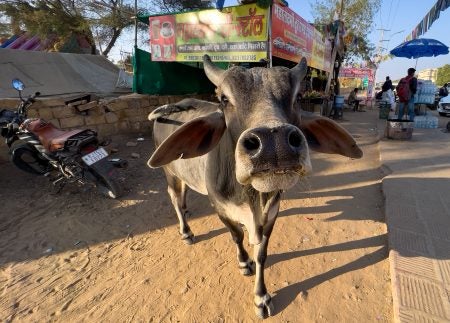
A local wanderer looking for a treat. Sorry, pal, I got nothing. Photo: William Roberson
Drivers and riders slow down and slowly go around them when they are in the road (which is often), usually without using a horn, but if need be, with a short beep beep to get them moving along, which the bovines appear to understand. The cows do not run, charge or panic, they simply saunter slowly onto the road… and then across it… and then off of it, secure in the knowledge they won’t be harmed. Herds of them stroll down highway shoulders. Cars, trucks, motorbikes, tuk tuks and all else come to a halt or tip toe slowly past as they cross the road in towns or on the open highway. It’s something to witness.
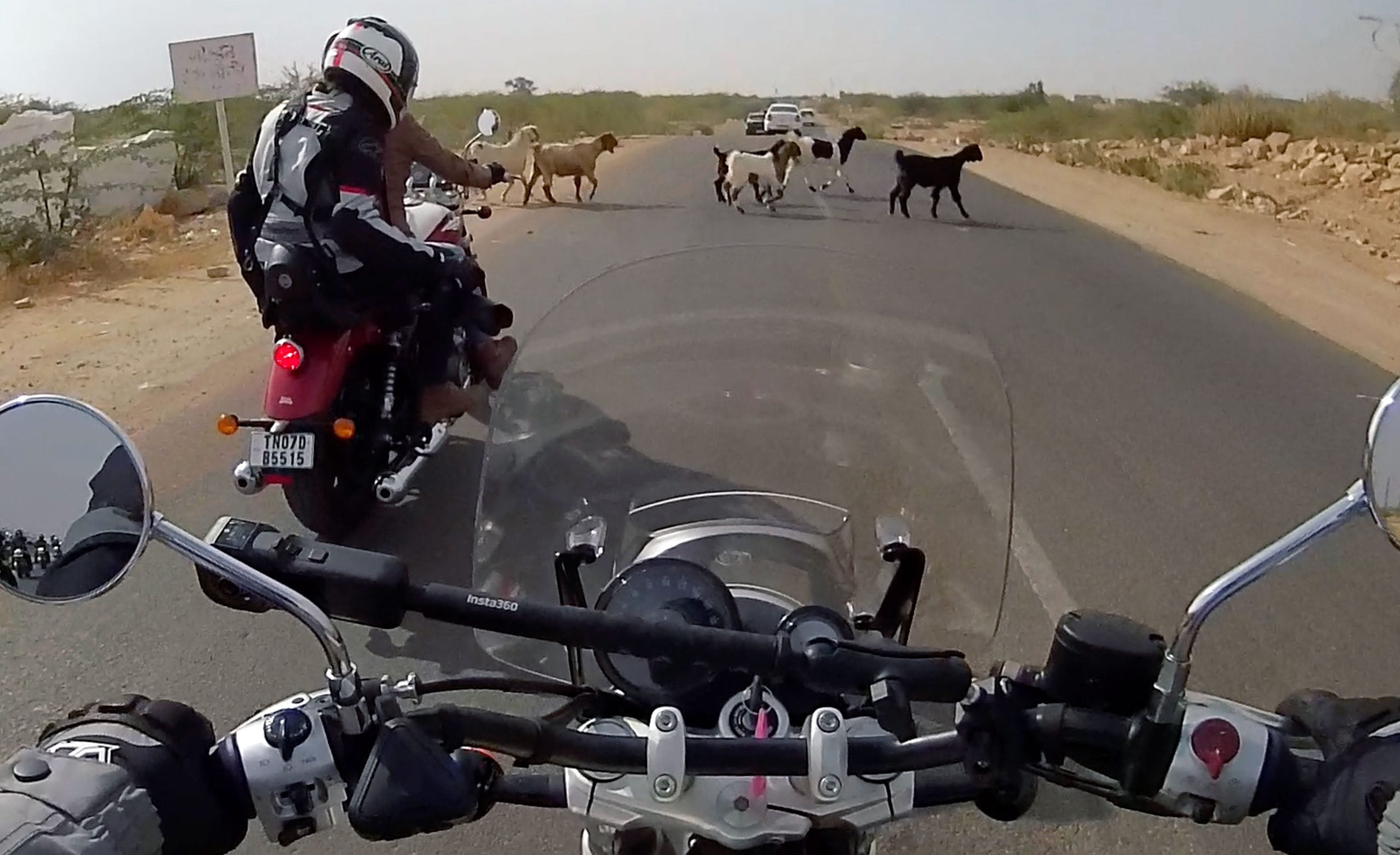
Goats usually travel in herds, and a few beeps gets them off the road. Usually. Photo: William Roberson
Goats and sheep seem to share this respect of animal space in rural areas, as does the occasional boar or camel. However, dogs don’t rate in India, and made up the vast majority of road kill we saw while riding. A dog was the only animal that charged at me while riding in India.

Sunrise in Jaisalmer as we head north to Khimsar. Photo: William Roberson
Perhaps the most intense experiences was the ride from Jaisalmer to the more northern city of Khimsar, a larger metro area and our ultimate destination. Leaving Jaisalmer at what must have been the peak of the morning rush hour, we threaded through narrow streets coursing with activity, including lurching school busses packed with kids leaning out windows to wave at us on our gleaming motorcycles, overloaded tuk-tuks carrying half a dozen people loaded for market, streams of often overloaded motorbikes with one to five people aboard, plodding farm tractors hauling trailers, street vendors pushing carts loaded with fruit and steaming pots of food, and a general mix of bicycles, pedestrians, cows, sheep and goats.
With the sun rising through the smoke of cooking fires and a foggy mist, we wove our way to the open highway north of town.
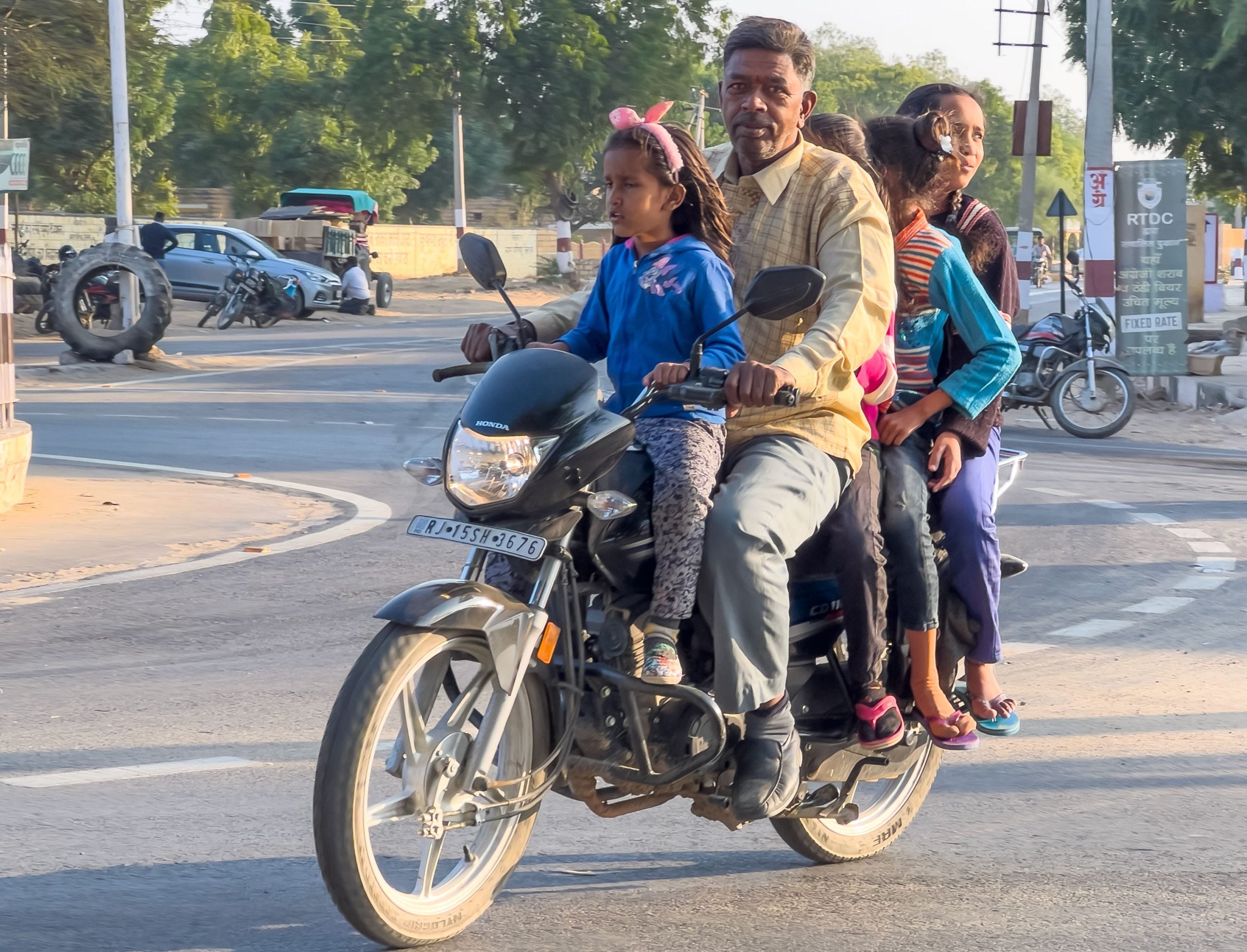
Those Internet memes of overloaded vehicles in India are pretty accurate, but for many families, their dependable motorbike is the only way they get around. Photo: William Roberson
And we didn’t tip-toe through town, either. Our Super Meteors were alternately hard on the gas or triggering the ABS as we dodged and weaved through the crowded city streets, merging and splitting through the melange of traffic. All the while, we had to look out for unmarked speed bumps, gravel patches, pavement slick and wet from who knows what, merging… everything, “wrong way” vehicles (usually small motorbikes, below) and still unfamiliar left-lane riding (for us Yanks). It was all senses on deck, all the time, and all turned up to 11.
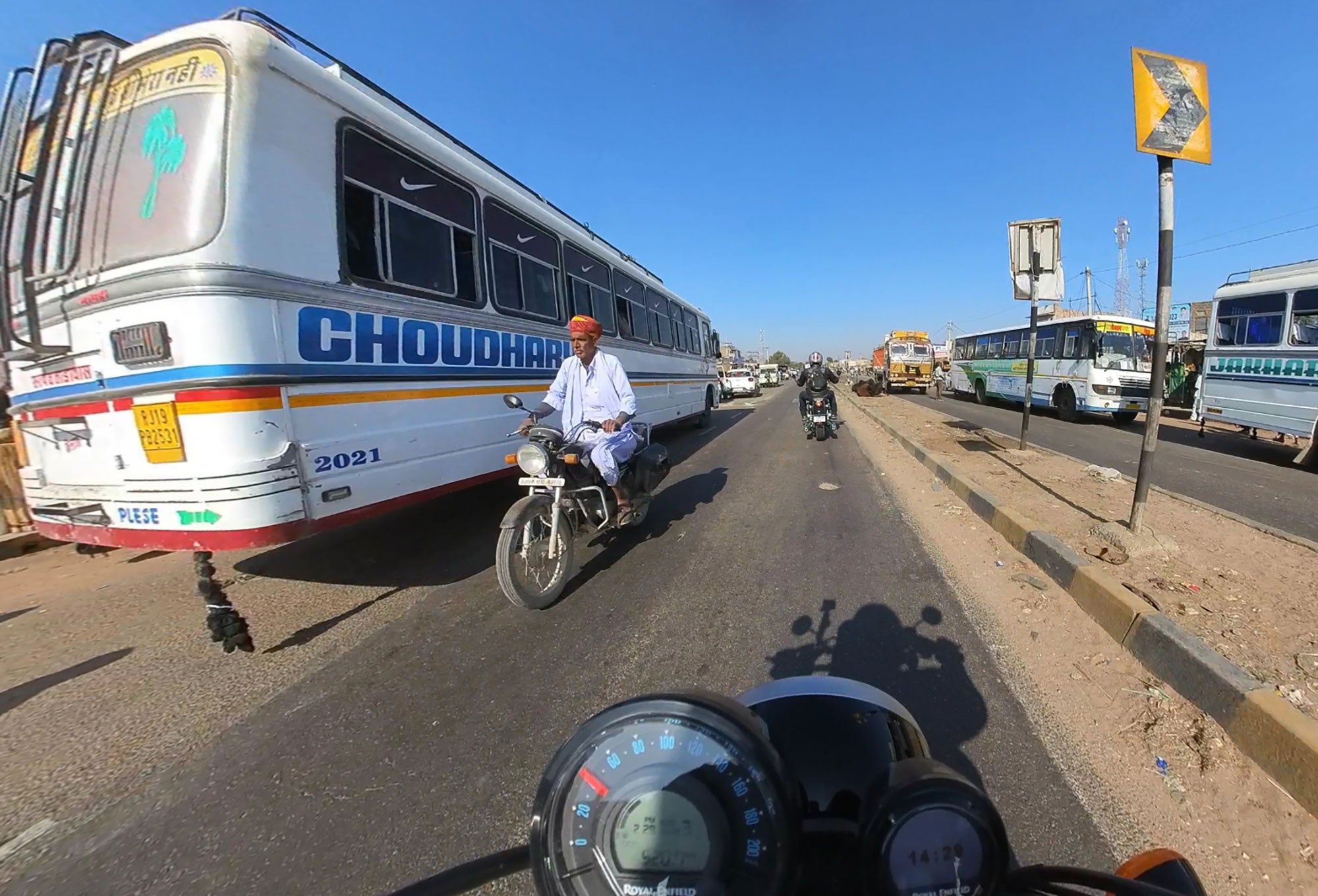
Sure, that rider on the left is going the “wrong” way, but he’s being very careful about it (and it’s common). Photo: William Roberson
Another memorable moment: Coming home after dark from a photo session, we rode through a major freeway road construction site that didn’t have a single cone, flagger or diversion clearly marked; we just blasted through the dirt, gravel and crumbling concrete until we arrived back on pavement. I’ve ridden in Japan, Mexico, Italy, New York City and some other crowded locales; they are nothing compared to this mix of hazards, velocity and visceral, visual overload. It was absolutely exhilarating.
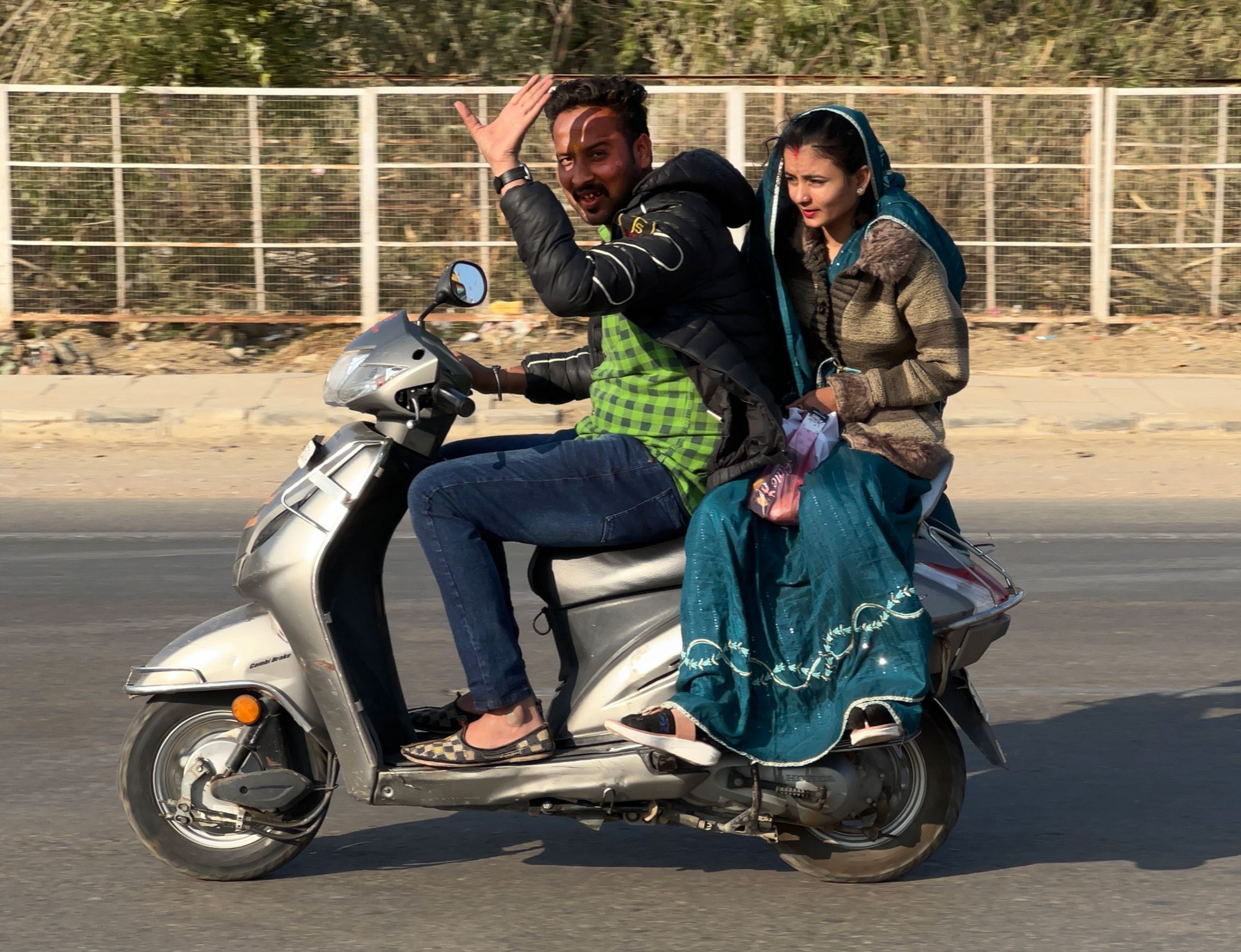
Most women we saw rode side-saddle, and many people waved or gave a thumbs up to us geared-up foreigners on those big, fancy motorbikes. Photo: William Roberson
I feared riders who might have less experience in crowded and congested urban confines might become casualties, but by the end of the ride, everyone was accounted for and all bikes remained upright. Part of that success goes to just using common sense while riding and getting in the groove, and a larger part goes to the Indian riders and drivers out on the roads with us in all manner of vehicles. Despite often being unhelmeted and talking on cell phones WHILE RIDING and driving, they are survival-honed transportation artists and were always able to make room for us to pass, turn, stop or join the flow of movement. I never saw a serious traffic jam or accident. It’s an enculturated driver’s ed that many countries—including the US—could learn from in many ways.
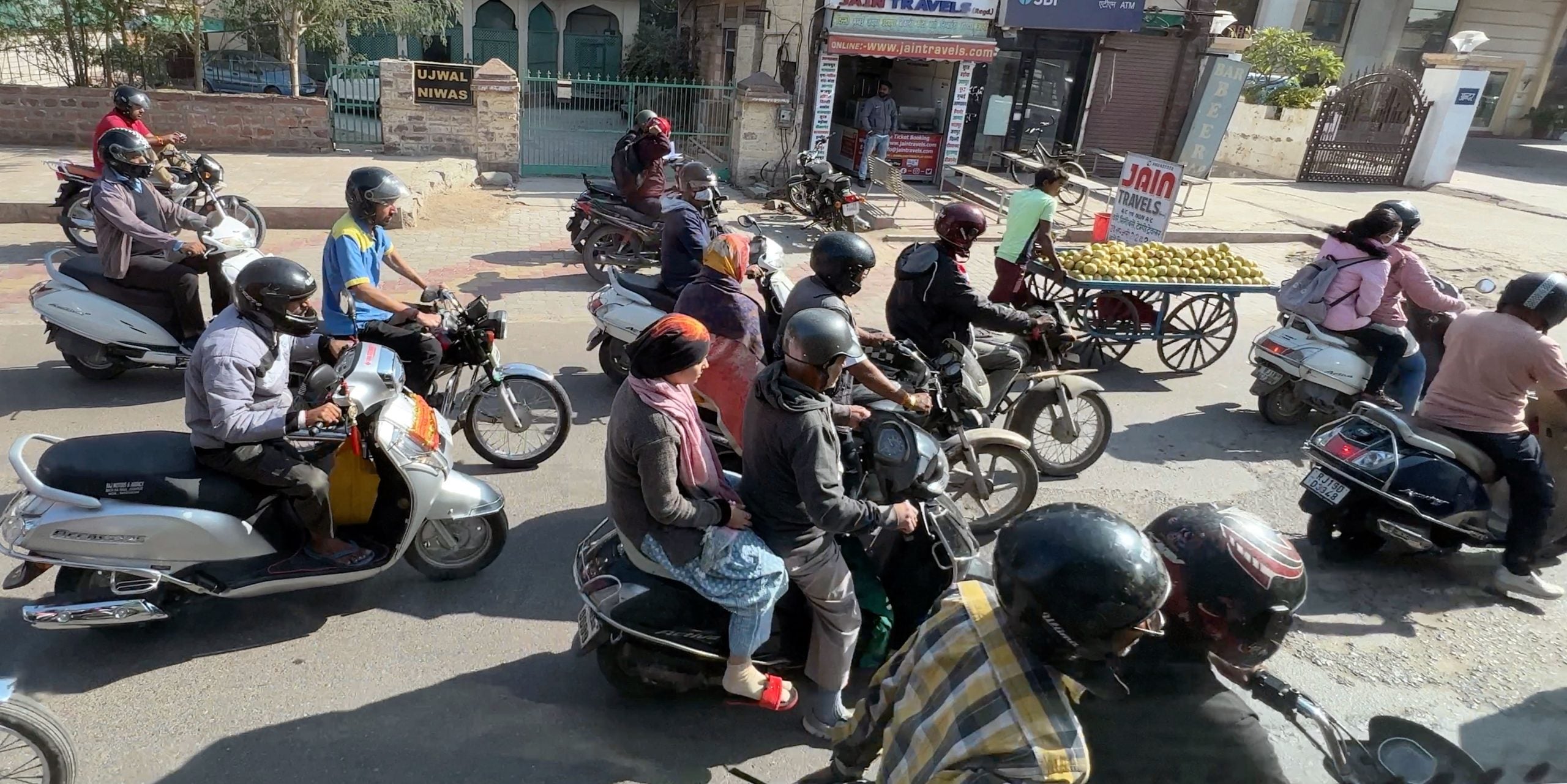
My vantage point on a tall tourist coach gave a good perspective on city traffic in the more metropolitan Jodhpur. Photo: William Roberson
The lack of road law enforcement, the scarcity of signals and the wide range of road users have resulted in drivers and riders that have excellent road awareness and also use every inch—or more—of the narrow stretches of pavement to flow across cities and rural highways. They have my gratitude and admiration.

In rural areas, dirt roads and small bands of pavement, usually just wide enough for a truck, link the country’s communities together. Photo: Royal Enfield/360Media
Outside of the cities, the main highways were typically narrow strips of asphalt barely two lanes wide. Spurs to small towns and tourist attractions were almost always narrow single-lane paved roads that required some dirt excursions while passing. Indian riders headed off the pavement without a thought it seemed, while us visitors had to conjure up some courage to make the needed space.

Sure, it’s a “cruiser” but we still had to power it through deep sand, dirt, rubble and other facets of India’s infrastructure. Photo: Royal Enfield/360Media
In many places, rural roads would quickly degrade into chopped-up pavement sometimes interrupted by sand, dirt sections and the usual animal appearances. It was better to slow your roll and enjoy the passage than try to make good time, lest you end up well off the pavement and into some less-savory roadside hazards. Moving through small villages, our big bikes brought out the curious and many Enfield admirers as well.
Conclusions

We rode in mostly flat or slightly hilly areas, and had clear, dry riding weather. Photo: William Roberson
Having ridden the Super Meteor 650 in the company’s home market of India, I better understand the decisions Royal Enfield makes in its design and production of 650cc-class motorcycles. I’m sure if Royal Enfield wanted to, it could conjure up a 100-plus horsepower, 1000 cc machine in a bid to take on the Japanese, Germans and Italians. But the Super Meteor 650 is made foremost for India, where toughness, reliability, usability, maneuverability and value are the overriding goals, not triple-digit velocities.
Yes, the Super Meteor 650 can top the ton, if just, but that gem of a motor is squarely aimed at real-world performance, where 40-odd horsepower and 38 pound feet of torque let riders click down a gear or two, pile into the throttle to pass and then dial up 6th to run long at 55 mpg to distant horizons. It’s the same 648 cc of fun found in my INT650, now tweaked for touring duty. The Super Meteors I rode ran without issue, with a smooth-shifting gearbox, effective brakes, good ergos and surprisingly good fit and finish.
Two days of hammering the Super Meteor 650 tells me that Royal Enfield has likely succeeded in building what they call a middleweight “cruiser” and what the rest of the world may even see as a standard with some forward-ish controls. How the market responds will be interesting.
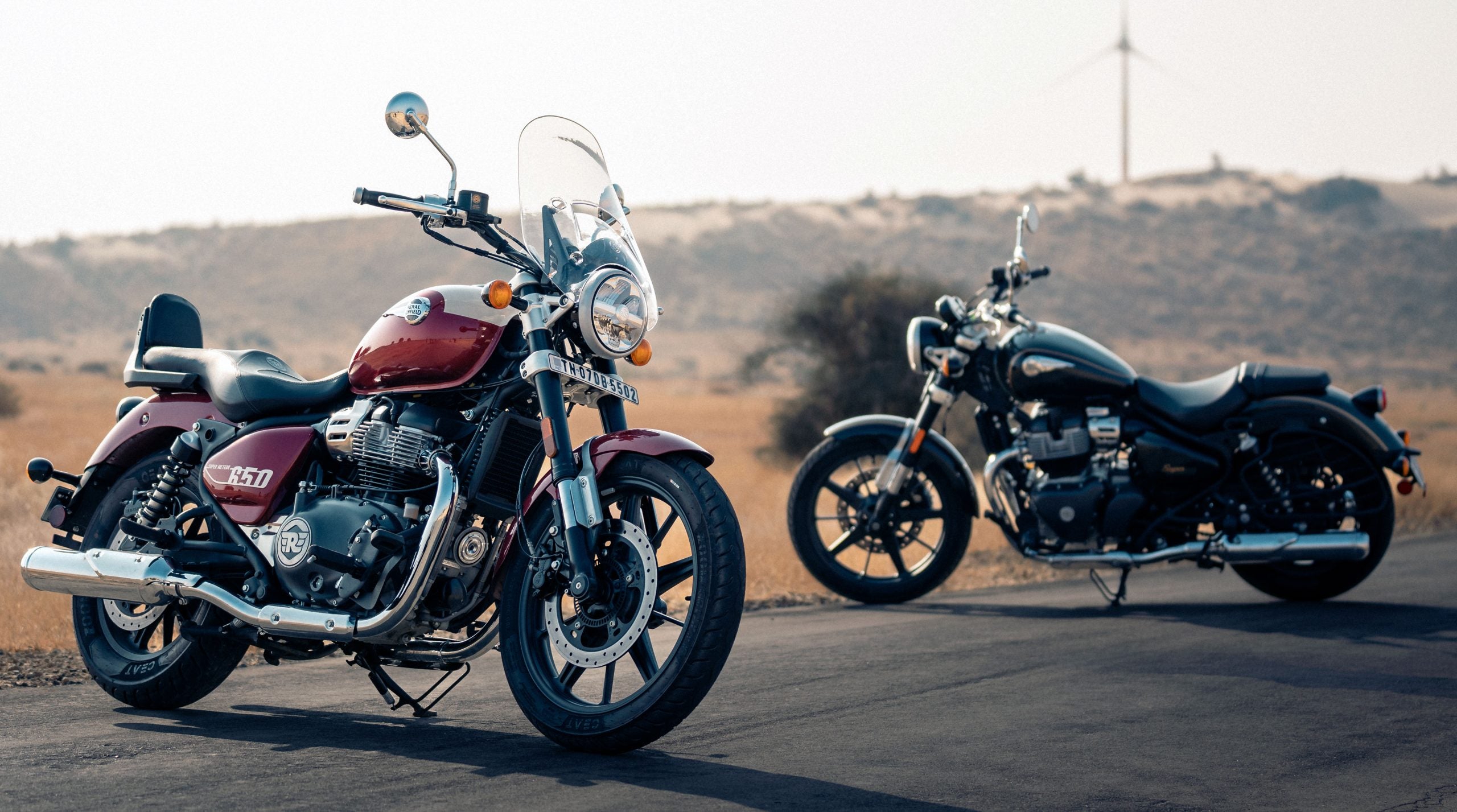
The Super Meteor Tourer I rode, plus the base bike. Photo: Royal Enfield/360Media
It even sounds pretty good despite EU/DOT compliant twin exhaust pipes. The touring version is a step up in comfort but I had no complaints while riding the base bike, which can be stripped down and spiffed up to emulate an urban roadster with little effort. Truly a versatile machine both functionally and aesthetically.
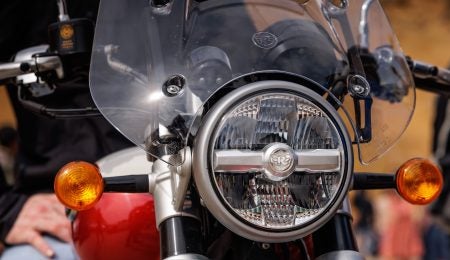
LEDs give the new headlight some serious candlepower. Photo: Royal Enfield
Is 650cc’s enough for touring outside of India? It is; just ask anyone who has loaded up a KLR650, DR650, Versys 650 or the like and set out for far horizons. A 650cc plant has long been a kind of just-right compromise between size, power, weight and performance. Going back to the 1950s and 60s, a 650 Triumph or BSA was a “big bike” for brave riders, but those longer legs also gave birth to many adventures that smaller machines might have not been able to serve. Today, a 650 is a beginner bike in many ways, but that versatility remains as our India odyssey repeatedly illustrated.
The Super Meteor has “cruiser” competition from Kawasaki’s lighter, faster 650 Vulcan S and Cafe, among others, but the Enfield adds in a distinct splash of character most hyper-modern machines lack. Upon my return to Portland after 23 hours in the air, I put the key into a Japanese 650 I have in for review and swung a leg over for the ride home from the airport. Underway, it felt precise, obedient, predictable, but also appliance-like, as anything can be after generations of refinement. Much like the small motorbikes we shared the road with in India, it is a vehicle of efficient transport. It was missing the duckata-duckata-duckata soundtrack from the Meteor’s two low-slung exhaust pipes, among other aspects of character the Enfield possesses.

In India (and in most places, honestly) you don’t really need 100+ horsepower to see the sights and travel in comfort. The Super Meteor builds on the success of the torquey 46 hp 650 P-twin; how it sells remains to be seen. Photo: Royal Enfield/360Media
Yes the “new 2.0″ version of the 650 P-twin is tighter, more responsive and perhaps a bit less visually quaint than my INT650’s engine, but it’s a far cry from the sterility of my Japanese review bike’s largely hidden power plant. Royal Enfield likes to emphasize that their bikes have a special vibe (the good kind) that engenders owner loyalty and has helped them realize huge market gains over the past few years, and from my time aboard, I can agree that, outside of a Harley or a vintage bike, the Super Meteor is a more sensory-engaging, more old-school machine. It was great fun to ride it hard in a place for which it is clearly designed.
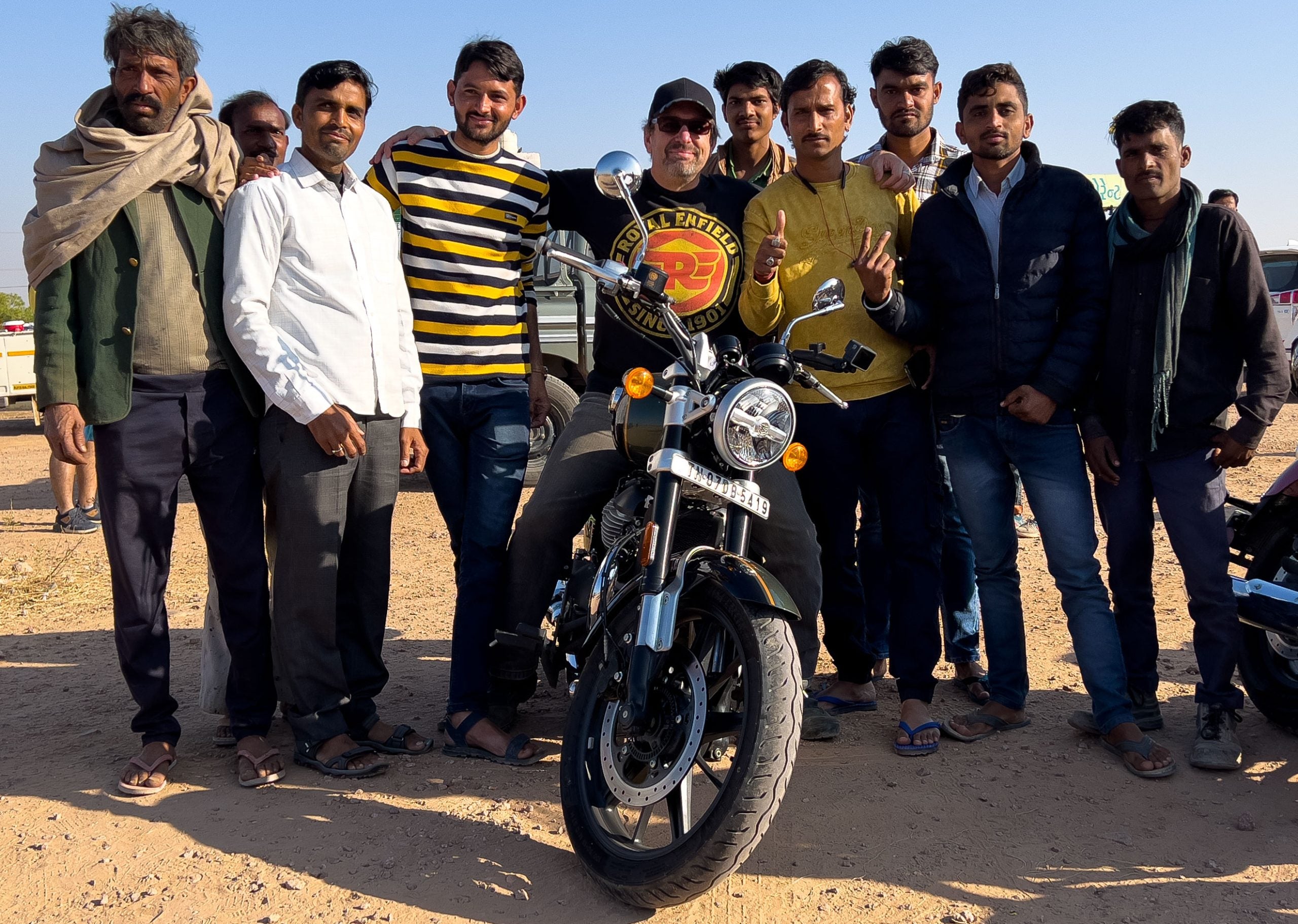
What an amazing trip to a colorful, friendly country. I’ll be back soon. Photo: Royal Enfield/360Media
What would I change? Speaking with Royal Enfield’s head of design over some end-of-the-ride beverages, I said on balance the Super Meteor was pretty much on target as is, but it would be nice if the engine was just another 100cc’s larger for some international markets, and if the front forks had some preload adjustability. I’d also like to see a tachometer return, even if it’s a digital one in the speedo or Tripper display. A second disc brake rotor up front would be a worthy add, even though I have no complaints about braking power from the 320 mm single-disc Brembo ABS setup. And if you’re going to make a tourer, cruise control is a nice perk. Outside of a tacho, those upgrades would require many changes to the 650’s base architecture, adding cost and complexity to the platform. He responded that the cruise control and tach were possible adds down the road, but for now, the 650 was going to remain a 650, as it represented a sweet spot in several markets that they were so far serving very well with the GT and INT.
Now, with three 650s twins on offer, I feel Royal Enfield is just one 650 twin away from covering all the bases: a 650 Himalayan. The newly updated engine is certainly tough enough, and I’d wager it’ll happen at some point. If it does, I’m happy to brave another 20-plus hours each way in Economy Plus to pilot it through its namesake mountain range. Here’s hoping.
I own a 2020 Royal Enfield INT650. Royal Enfield flew me to India and provided lodging, food and motorcycles for this story. Look for a long-term ride review of the Super Meteor 650 later this year. See more photos from the Super Meteor 650 reveal below.
Gear Box:
Helmet: Forcite carbon-fiber MK1S Smart Helmet (review coming soon)
Boots: TCX Infinity 3 Mid WP
Gloves: Light: Rocky Mountain MSR Wind Block w/D30 Warm: Tourmaster Roamer WP
Pants: Sa1nt Unbreakable Slim Jeans
Riding glasses: Tifosi Optics custom prescription with self-tinting lenses
Cameras: Lumix DMC-FZ2500, Insta360 One RS, Apple iPhone 13 Pro, Forcite MK1S Built-in HD helmet camera
- Photo courtesy Royal Enfield/360Media
- Photo: William Roberson
- Photo: William Roberson
- Photo: William Roberson
- A local wanderer looking for a treat. Sorry, pal, I got nothing. Photo: William Roberson
- Photo: William Roberson
- Photo: William Roberson
- Photo: William Roberson
- Photo: William Roberson
- Photo: William Roberson
- Photo: Royal Enfield/360Media
- Photo: William Roberson
- Photo: William Roberson
- Photo: Royal Enfield/360Media
- Photo: William Roberson
- Photo: William Roberson
- These boys ran right over to get a closer look at the bike. Photo: Bill Roberson
- Photo: William Roberson
- Photo: Royal Enfield/360Media
- Photo: Royal Enfield/360Media
- Photo: Royal Enfield/360Media
- Photo: Royal Enfield/360Media
- Photo: Royal Enfield/360Media
- Photo: Royal Enfield/360Media
- Photo: Royal Enfield/360Media
- Photo: Royal Enfield/360Media
- Photo: Royal Enfield/360Media


